

10 Macabre, Strange & Interesting Dark Tourism Destinations In Rome!
R ome, the eternal city of captivating history and timeless beauty, has long been a magnet for travelers seeking to unravel its iconic wonders.
But beyond the well-trodden paths that lead to the Colosseum, Vatican City, and the Trevi Fountain lies a world of secret treasures waiting to be discovered.
For the intrepid souls who yearn to veer off the beaten track, Rome’s offbeat attractions promise an enchanting journey into the city’s lesser-known, yet equally captivating, corners.
So let’s trade in familiarity for something a little more unexpected, and step away from the crowded tourist scenes we’ve seen a dozen times before. From ancient underground crypts to monuments plagued with morbid pasts, we want to explore what’s hidden in quiet alleyways in the dark side of tourism in Rome.
Each of these offbeat gems offers a unique perspective on the city’s multifaceted history and vibrant culture.
So, lace up your walking shoes and open your heart to a Rome less traveled – where stories of the past and the pulse of the present intertwine to create an unforgettable adventure through Rome’s best dark tourism destinations.

The Macabre, Strange & Interesting Dark Tourism Destinations of Rome!
1. the colosseum.
Centuries ago, the Romans sat at the head of the metaphorical global table, with an unfathomable infrastructure and society that in some instances outdoes modern times.
But unlike modern society, the world of technology was somewhat premature. Instead of being able to widdle away mindless hours watching TikToks and Youtube videos, the Romans had to find something interesting to pass the time.
Ancient Ampitheatres began to spring up, and the cities would flock in droves to the stands to watch Gladiators battle to the death.
The Colosseum is considered today, one of the first Dark Tourism destinations on earth, not just Rome. Its visitors were not drawn there for theatrics. They wanted to witness the guts and glory of heart-stopping brawls, which often had a bloody ending.
It’s only recently as historians delve deeper into the history and significance of the Colosseum, that the morbid horrors became apparent. Beneath the ring sat a maze of prison cells, in which unwilling slaves and animals were kept and tortured. Death not only plagued the surface, but lingered beneath the soil as well.
While the Colosseum was eventually left to ruin, it became one of Rome’s most popular tourist destinations. With some modern adjustments, guests can step onto ancient turf and feel the breath catch in their throat.
Aside from the jaw-dropping architectural feats, as you listen to helpful tourist guides regale on Greek Tragedies, the silence that clings to this ancient stone relic begins to surface a new meaning.
It may have once been a popular entertainment destination, but that will never hide from the fact that thousands of people died here, all in the name of sport.
Location: The Colosseum, Rome, Italy
Tags: Dark History

2. Torre Argentina
Largo di Torre Argentina was unearthed as part of Bento Mussolini’s effort to rebuild the great city of Rome in 1929.
Four distinct temples revealed themselve, and after becoming a fascination to archaeologists and historians alike, it was rumored that these ruins were part of the very same complex in which Julius Caeser was so infamously stabbed by Brutus.
It’s perhaps one of the most famed Greek Tragedies to date, and is still reinacted in theatres across the world today.
Unfortunately, Mussolini’s mission didn’t get too much further, leaving the ruins standing empty just long enough for the self-proclaimed royalty of domesticated animals to turn it into a permanent home.
That’s right, the cats that sleep on every sun-soaked stone in Italy have turned the ruins of Julius Caeser’s murder site into their cosy new abode.
But don’t worry, the city isn’t allowing the population to grow unchecked. In fact, the ruins have become a sanctuary that caters mainly to ferals with special needs.
The gattare, or as we know them today, childless millennial females, take very good care of the feral population, ensuring they’re well fed and happy in their home.
It’s a wholesome ending for a murder site, if only someone would convert the Amityville Horror House into a puppy rescue!
Location: 1-41 Via di Torre Argentina, Rome, Italy
3. Domus Aurea
Now this a destination that’s definitely NSFW, at least if you attended an event here several hundred years ago.
Emperor Nero built the Domus Aurea as a grand palace to sit on the Oppian Hill. Although it’s a palace fit for royalty, Nero hardly saw it as a permanent abode, instead frequenting it as a leisurely hideaway whenever he felt fit.
While most royalty prefer to soak up their lavished lifestyles with luxurious parties and extravagant ownership, Nero… Well. Nero took a different turn. For anyone who visited the Domus Aurea, they’d say it is the pinnacle of opulence, stacked with ivory, marble and mosaic.
But it was a site that caused ridicule amongst Nero’s followed due to the type of entertaining that happened behind closed doors. Basically, whenever Nero was around, you could expect to find a trail of ladies (and sometimes men) and a sock attached to the door knob.
Ah yes, this mad King was quite shameless. In fact, in a last ditch attempt to bury the shame of the Nero’s Dome of Pleasure, his pride and joy were buried under constant construction.
Ironically, this just kept the frescoed halls in perfect condition until it was rediscovered by chance again some centuries later. Until its immaculately kept halls began to corrupt to outside exposure.
The intricate details were destroyed, and all that stands now is a shell of the former pleasure house it used to be, with some interesting graffiti courtesy of Casanova, mind you.
It’s open to tours, and as it might be a struggle to picture the ruins as some ancient version of Christian Gray’s Red Room, you may need is an imagination equally as wild as Nero’s.
Location: Via della Domus Aurea, 1, Rome, Italy
Tags: Obscure Tourism
4. Museum of the Holy Souls of Purgatory
To anyone with a slight sense of world history, you’d know that Rome is amongst one of the holiest places in the world, thanks to the Vatican City being so nicely confined within the city limits.
So it’s no surprise that you’ll find quite an intricate maze of religious tourism to navigate. And yes, while the stunning churches and
The Museum of the Holy Souls of Purgatory is an eerie destination that holds a lot of unanswered questions. It’s a tribute to the ancient Catholic belief that when you pass, your soul sits in a strange state of inbetween. Your soul can only ascend from Purgatory, if it can atone for its sins.
This was rumored to be further urged along by the prayers of still living loved ones. Strangely enough, a similar belief exists elsewhere where Catholicism is quite prominent. Maybe Disney’s Coco was on to something?
Anyway! It is said that some souls are able to make their presence known by reaching through the veil of life and death. It is because of this, that the exhibits of the Museum of Holy Souls of Purgatory was made possible.
Cloth, singed with the handmark of an unknown entity, pages of books with seared paper. The small but intriguing collection really makes you ponder about the blurry line between life and death, and whether there is indeed some kind of afterlife to look forward to.
As if our quarter-life crises were not enough, add a little existential crisis to that Roman Holiday, would ya?
Location: Lungotevere Prati 12, Rome, Italy
Tags: Dark Tourism, Religious Tourism
5. Mausoleum of Augustus
The Romans knew how to live and die with flare, after all, look at all the theatrics involved with Julius Caeser’s assassination! Well, we can blame the first Emporer of Rome, Augustus for that.
In fact, after a trip to Egypt in 28 BC, Augustus felt quite deeply that he’d like to do as the Egyptians do, and wanted to build himself some sort of monolith to remember his legacy by.
Thus construction on Augustus’ Mausoleum began.
Today, the ruins of his colossal burial site stand as a waypoint in the centre of Rome, right by the Tiber River. It is the final resting place to several of Rome’s leaders, with Augustus being the first, and Nerva being the last.
The site sat dormant, and privy to ruin from 98 AC up until the early 20th century when it was briefly used as a concert hall. Eventually it was restored, or somewhat at least, to its rightful purpose as a tomb of Kings. If you ever find yourself in the area, take a moment to admire the stunning intricacy of detail that went into this glorified graveyard.
And take a moment of silence for the former rulers of Rome, after all, they changed the history of the modern world indefinitely.
Location: 61 Via Mario Dè Fiori, Rome, Italy
Tags: Grave Tourism
6. The Catacombs of San Sebastian
The Catacombs of San Sebastian lie nestled along the 6 kilometer stretch of Via Appia. In 350 AC, the remains of the martyr Saint Sebastian were put to rest at this site, in a basilica built to commemorate and honor him.
It was amongst one of the first of its kind, starting a long-standing burial tradition with deeply embedded roots in the Christian faith to this day. Without the Catacombs of San Sebastian, we wouldn’t have half the global dark tourism sites that attract thousands of visitors year round.
The walls of the catacombs are adorned with frescoes and inscriptions that depict scenes from the Bible and Christian symbolism. And throughout the years it started to gain a niche collection of items including a set of marble footprints said to be from Jesus himself.
You don’t have to be a Christian to admire the delicate details put into this monument, which, for the time, was quite an incredible feat! Guided tours are available which will lead you through the hallowed tunnels where you can gaze at the religious artistry that adorns its walls, and hear stories about its significance throughout history.
Aside from the eerie passages though, there’s nothing entirely “dark” about visiting this catacomb. That is, if you can get past the fact that there’s a bunch of bones buried behind the walls that surround you.
Location: Via Appia Antica 136, Rome, Italy
7. Ospedale delle Bambole
Taking a stretch beyond the religious relics of Rome, we want to introduce you to a destination that’s as wholesome as it is disturbing. Ospedale delle Bambole, which translates to “the Doll Hospital” is exactly what it sounds like.
And luckily for those with Pediophobia, a fear of inanimate humanlike objects (thanks Annabelle), this creepy little store is tucked away in a cobblestone alley that most tourists don’t know to look for. But for those of us fascinated by the strange and let’s face it, downright creepy, this is the spot for you!
While the motive behind this destination is far less sinister, we can’t help but shudder at the mirage of dolls heads in different states of disrepair staring at you through the glass window.
If you step inside, you’ll instantly feel the gaze of hundreds of porcelain and plastic dolls burrowing in to you. This small little shop is actually a tiny workspace run by a mother-son duo who’s main priority is to restore porcelain dolls and objects to their former glory.
For collectors, it’s a paradise!
Location: 29 Via Ripetta at Via del Vantaggio, Rome, Italy
8. Museo Storico Nazionale Dell’ Arte Sanitaria
The Museo Storico Nazionale Dell’ Arte Sanitaria is a well hidden part of the history of Rome, namely its medical history. It’s found quite close to Vatican City, and is an often overlooked tourist attraction that not too many people have heard about.
It is part of the Santo Spirito in Sassia, a 12th century learning hospital, and has converted the student ampitheatre into a mirage of exhibits. Museums like this, while macabre to some, are vital in showing the history of medicine, and can be quite eyeopening in terms of our evolution to modern medicines today.
From the porcelain anatomical recreations of the 17th century, to full recreations of alchemy labs and pharmacies, this museum is definitely worth a visit for anyone with a fascination for the medical field. Or just plain morbid curiosity.
Some of the exhibits are quite lifelike, so we do advise that it’s not a tourist attraction for the faint of heart. After all, standard medical practices up until the 21st century included labotomies and some other unbelievably strange operations that fit straight into a torture playbook.
Location: Lungotevere in Sassia, 3, Rome, Italy
Tags: Dark History, Obscure Tourism
9. Santa Maria della Concezione Crypts
Visiting the Santa Maria della Concezione Crypts is an experience that transcends the realm of the ordinary. It is a place that is equally as haunting as it is awe-inspiring!
Located beneath the Church of Santa Maria della Concezione dei Cappuccini in Rome, Italy, these crypts are renowned for their unique and macabre decoration. The remains of Capuchin friars have been artistically arranged to create intricate designs on the walls and ceilings, much like the Paris Catacombs!
Built in the 17th century, Baroque artists and architects took inspiration from the delicate line between life and death.
While the original point of the crypts were to give the Capuchin friars a final resting place, those tasked with the assignment took their artistic liberties to the next level, creating macabre murals made from skulls and femurs, and even human bone chandeliers!
While the intricacy and attention to detail might be enough to steal your breath away, one thing is undeniable – the Santa Maria della Concezione Crypts are a stark reminder of the afterlife. The bone decor within the crypts hold deep symbolic meaning. They serve as a visual representation of the cycle of life and death.
They are open to the public, and tours are not only welcomed, but encouraged. In fact, the crypts have become a significant cultural and historical site in Rome, capturing the imaginations of tourists of all kinds. But, of course, this destination holds a special place in the hearts of Dark Tourism lovers.
Location: Via Vittorio Veneto, Rome, Italy
Tags: Dark Tourism, Grave Tourism
10. Cimitero Monumentale del Verano
It goes without saying that the majority of Rome’s dark tourism industry thrives off their bountiful burial sites. Cimitero Monumentale del Verano is no exception, and has become a much beloved offbeat destination for lovers of art, architecture, and death. What a combination!
Established in response to the increasing need for burial spaces in a growing city, the cemetery emerged during a period marked by profound cultural changes. As a result, it not only became a final resting place but also a reflection of evolving architectural and artistic trends that shaped the era.
It seems that everybody in Rome wants a lavish burial site of their own! The influences here are as diverse as the people they commemorate, from Art Nouveau to Gothic, the monuments, masauleums and statues make this cemetery a sight to behold!
It’s an attraction that’s now packed with symbolism and for art lovers, or people who simply enjoy a good riddle, it’s interesting to try and decipher the deeper meaning behind each intricate detail engraved in the tombstones.
The cemetery serves as a quiet oasis where history and art entwine, and it’s a good way to remind yourself of the fragility of life. And as far as cemeteries go, this well-maintained and beautiful dedication to the deceased is not as creepy as you’d hope.
But, if there’s ever a zombie uprising, Cimitero Monumentale del Verano wouldn’t be the worst place to get eaten alive.
Location: Piazzale del Verano, 1, 00185 Roma RM, Italy
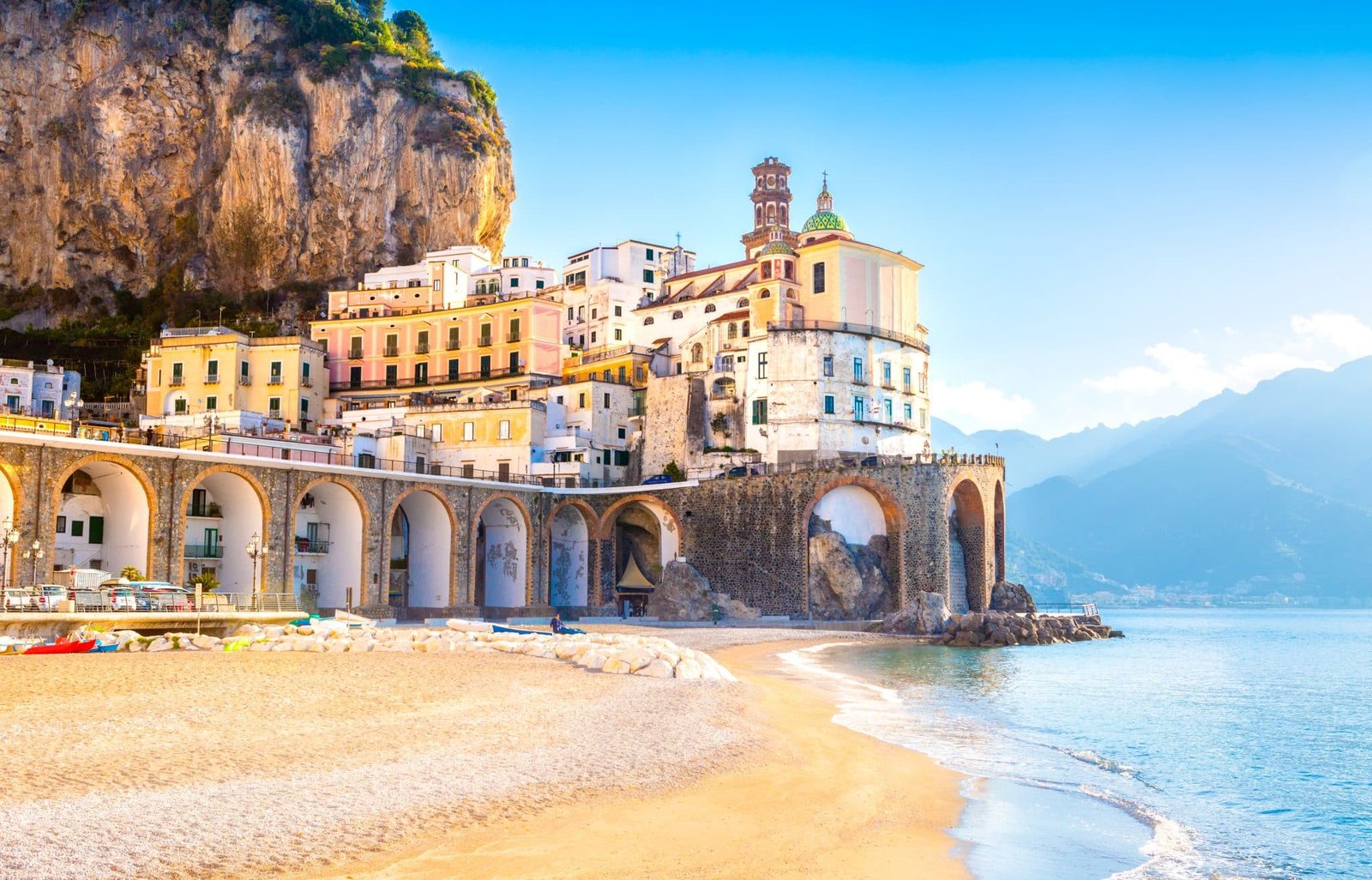
Related Posts

Athens vs Rome An Honest Comparison To Help You Choose
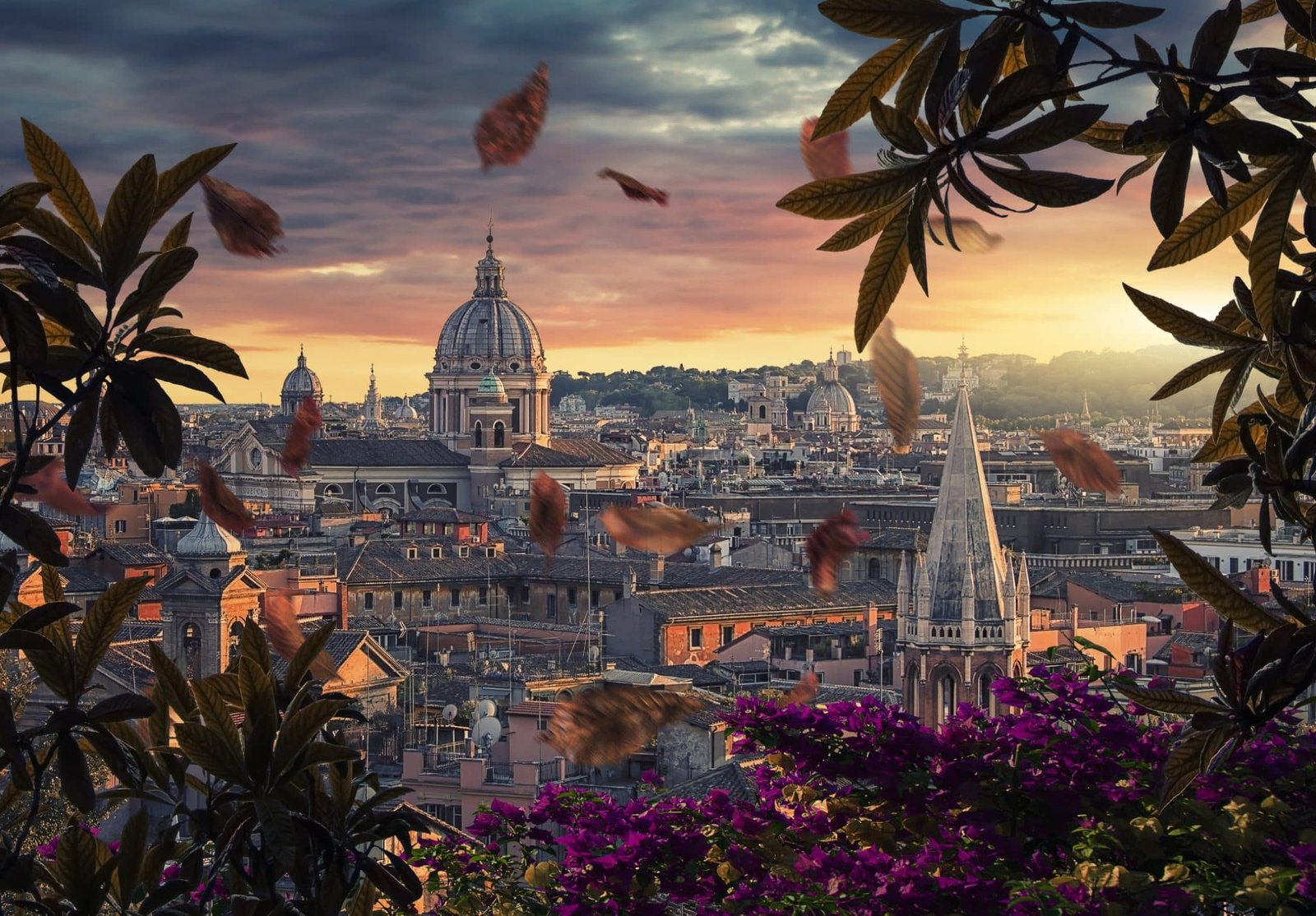
Rome or Barcelona: An Honest Comparison To Help You Choose!
10 macabre, strange & interesting dark tourism destinations of paris.

Lorem ipsum dolor sit amet, consectetur adipisicing elit sed.
Follow us on
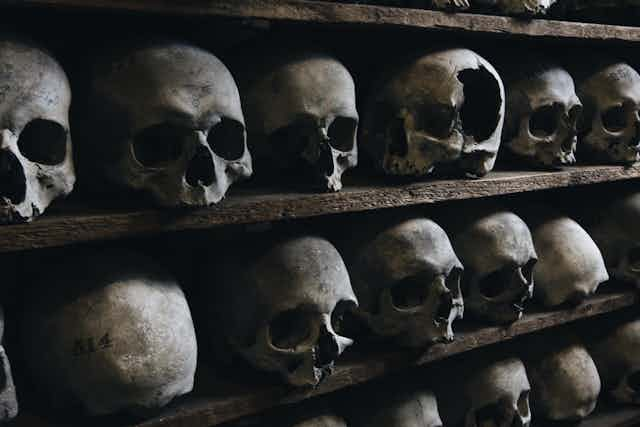
It may be macabre, but dark tourism helps us learn from the worst of human history
Lecturer in Business, University of Salford
Disclosure statement
Dr Neil Robinson does not work for, consult, own shares in or receive funding from any company or organisation that would benefit from this article, and has disclosed no relevant affiliations beyond their academic appointment.
University of Salford provides funding as a founding partner of The Conversation UK.
View all partners
Dark tourism has become a much more well-covered pasttime in recent years, in which a macabre fascination lead tourists to travel to various places not served by Thomas Cook: the sites of battles and genocides, war cemeteries, prisons, and even current warzones such as Syria .
The 20th century alone has provided such a long list of places at which catastrophes or great loss of life and suffering has occurred. Sites visited range from the spot from which JFK was assassinated, to prisons such as Alcatraz in San Francisco, through to battlefields of the World Wars, or the vestiges of genocides such at Auschwitz in Poland or Tuol Sleng in Phnom Penh, Cambodia. It’s not everybody’s cup of tea, but we shouldn’t condemn those for whom this is an interest.
Dark tourism appears to be a manifestation of our media-rich society through which information found online may persuade us to see historical sites in person. But its origins can be traced back much further than the fascination with death and disasters of the 19th and 20th century. In the 11th century, people and pilgrims often visited places with religious significance such as Jerusalem, where the location of Christ’s crucifixion is a popular attraction; tourists visited Gettysburg, the site of the bloodiest battle of the American Civil War in 1863; and in more recent centuries, the Grand Tour offered an opportunity for the wealthy to experience Europe, with sites such as the classical ruins of the Colosseum in Rome – which in the name of entertainment saw execution, torture and death – one of the must-see attractions.
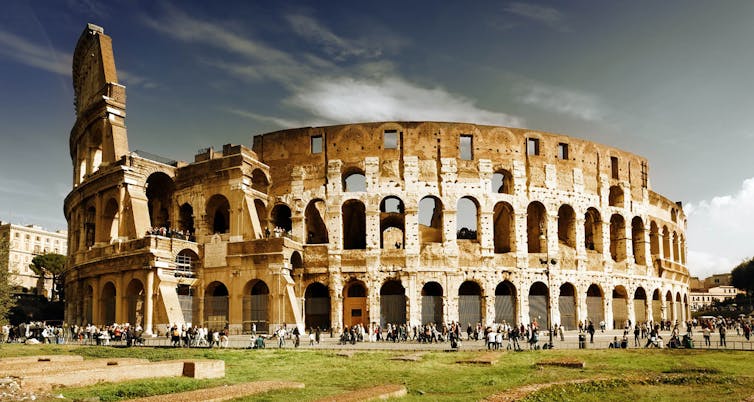
Today, in parallel with the growth in popularity of dark tourism is the enormous growth of social media and the 24-hour news economy. The ease of access to such blanket coverage through the web, Facebook and Twitter has increased people’s awareness of, and fascination for, these historical sites of war, conflict and catastrophe. For example, the last decade has brought a surge in visitor numbers to Chernobyl , where guides take visitors around the abandoned city of Pripyat (radiation levels permitting) which has been deserted since the nuclear power plant explosion on April 26, 1986. The 30th anniversary this year has in itself added to interest in visiting the overgrown and crumbling city.
As with tourism of any kind, this greater footfall brings benefits. In this case, not just the economic boost but also as a tool of education and even conflict resolution. For example, the taxi tours of Belfast’s murals , which document Northern Ireland’s Troubles, offer visitors a way to understand the history and provide the communities involved a means to reflect and move on from the conflict. This model is viewed with interest and hope by moderates on both sides of the Arab-Israeli divide searching for a peaceful solution for the long term.
The tours of Robin Island prison in South Africa, where Nelson Mandela spent 18 years incarcerated among many others, starkly present how those imprisoned by a corrupt and discriminatory political regime can later engage in peace and reconciliation. The Soweto township tours in Johannesburg have acted in part as a means through which generations of South Africans can better understand their country’s dark past and help to establish truth and reconciliation for the future.
Dark tourism should not in my opinion by viewed as unethical, repugnant or even a self-indulgent activity. Certainly some dark tourists may engage in their pursuits for all the wrong reasons, seeing death and destruction as a commodity to be consumed with little thought for those who caught up in its wake. But others visit such sites to pay their respects, to better understand the magnitude of death and destruction, and to inform the outside world of the details of terrible events – even in some case offering to help. These are positive effects that may come from so much pain and suffering.
We should strive to better understand the origins of the terrible events of human history to be more able to prevent us repeating them. In this regard, that more people visit sites associated with dark tourism and learn about them should be seen as a positive.
- Death and Dying series
- Dark tourism

Program Manager, Teaching & Learning Initiatives

Lecturer/Senior Lecturer, Earth System Science (School of Science)

Sydney Horizon Educators (Identified)

Deputy Social Media Producer

Associate Professor, Occupational Therapy
Indulge Your Dark Side With A Ghostly Tour Of Rome's Crypts And Catacombs
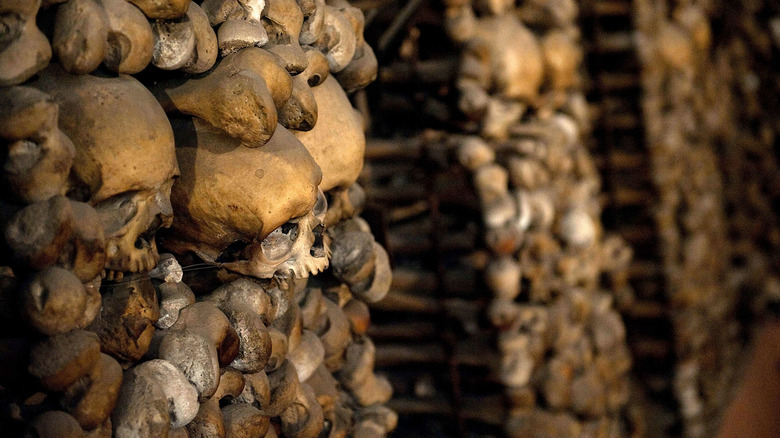
When you think of Italy, more than likely thoughts and images of the rolling hills of Tuscany ; the stunning beaches of the Italian Riviera and Amalfi Coast; the magical islands of Ischia and Capri with their quaint trattorias along narrow, cobblestoned streets; and the gondola-laden canals of Venice come to mind. Vibrant and bustling tourist destinations like Florence , Rome , and Milan are known for their rich history, ancient culture, world-renowned artwork, and larger-than-life architecture and monuments. And while Italy exudes all this and more in present day, its ancient past was quite a bit more haunting and much more terrifying.
Blood-soaked arenas and corpses of animals, gladiators, soldiers, slaves, and prisoners dominated the country's landscape. The smaller, ancient Roman city of Capua within the Campania region served as training grounds for notorious gladiators such as Spartacus, Spiculus, and many more, as referenced by the History channel. The grand Flavian Amphitheater in Rome — also known as the Colosseum — was a historic battleground where chariot races, gladiator combat, animal hunts, and games took place regularly. The Eternal City itself: a mass secret burial ground of saints, sinners, pagans, and Christians.
The wonders of the dead amongst the living in Rome
While Rome's city streets are bustling with tourists and residents, its underground network of secret burial chambers reveals a city of the dead. If history wrought with horror and bloodshed fascinates you, Rome's dark, ancient past comes to light via modern-day guided tours facilitated by Dark Rome , allowing you to indulge your dark side with a ghostly tour of the Eternal City's crypts, catacombs, and much more. And there's no better way to experience the intriguing and ghastly history shrouding the city's deathly past than through The Original Crypts and Catacombs Tour , where participants will experience a historical tour with an authentic archaeologist guide.
Or perhaps mysterious paranormal events, phantoms, spirits, and all things that go bump in the night does more for you than just raising the hair on the back of your neck and arms. If that's the case, the Ghosts, Mysteries and Legends of Rome Night Walking Tour will pique your love for ghost stories, murder, and mayhem. If you can't decide between the two because your strange fascination for the dead is so strong, Dark Rome has combined both of these horrifying tours just for you in their Dark Rome Combo Saver: Crypts and Catacombs plus Ghosts Mysteries and Legends of Rome tour. This tour is so in-depth, it provides over eight hours of frightening yet eye-opening information into Rome's sordid past.
Rome's dark, ancient past brought to life
Further your intrigue of the city's monumental, historical past by standing on the shoulders of giants and learning more about the famous gladiator battles and medieval executions upon Rome's hallowed soil by touring the Colosseum. Dark Rome offers three fascinating tours where the participant will feel like a spectator within this massive, ancient ruin. The Colosseum Tour with Roman Forum and Palatine Hill offers historical insight by day, whereas the Colosseum Evening Tour with Arena Floor and Roman Forum affords a unique opportunity to visit the Colosseum, arena, and forum by night. Should you prefer a smaller group tour, the Small Group Colosseum Underground Tour with Roman Forum, Palatine Hill & Gladiator Arena offers a "skip-the-line" service, whisking you into the Roman amphitheater, revealing its underground secrets.
It goes without saying that while present-day Rome is bursting at the seams with people, motorized vehicles, and both ancient and modern buildings, its centuries-old past, with its fascinating historical events, obsession with fighting to the death, and honoring the dead, still to this day holds its place firmly in history books, and within the framework of Rome's landscape, beguiling all of us now and for years, if not centuries, to come.

- dark tourism
- Andaman & Nicobar
- Bosnia & Herzegovina
- Channel Islands
- Cyprus (North)
- Czech Republic
- Dominican Republic
- Easter Island
- El Salvador
- Falkland Islands
- French Guiana
- Great Britain
- [Nagorno-Karabakh]
- Netherlands
- New Zealand
- Northern Ireland
- North Korea
- Philippines
- South Africa
- South Georgia
- South Korea
- Switzerland
- Transnistria
- Tristan da Cunha
- Turkmenistan
The Colosseum, Rome

> More background info
> What there is to see
> Location
> Access and costs
> Time required
> Combinations with other dark destinations
> Combinations with non-dark destinations
> Photos

- disclaimer & privacy policy
© dark-tourism.com, Peter Hohenhaus 2009-2024
- Account and Profile
- Newsletters & Alerts
- Gift Subscriptions
- Home Page U.S. & World | Regional
- White House
- Courts and Law
- Monkey Cage
- Fact Checker
- Post Politics Blog
- The Post's View
- Toles Cartoons
- Telnaes Animations
- Local Opinions
- Global Opinions
- Letters to the Editor
- All Opinions Are Local
- Erik Wemple
- The Plum Line
- PostPartisan
- DemocracyPost
- The WorldPost
- High School Sports
- College Sports
- College Basketball
- College Football
- D.C. Sports Bog
- Fancy Stats
- Fantasy Sports
- Public Safety
- Transportation
- Acts of Faith
- Health and Science
- National Security
- Investigations
- Morning Mix
- Post Nation
- The Americas
- Asia and Pacific
- Middle East
- On Leadership
- Personal Finance
- Energy and Environment
- On Small Business
- Capital Business
- Innovations
- Arts and Entertainment
- Carolyn Hax
- Voraciously
- Home and Garden
- Inspired Life
- On Parenting
- Reliable Source
- The Intersect
- Comic Riffs
- Going Out Guide
- Puzzles and Games
- Theater and Dance
- Restaurants
- Bars & Clubs
- Made by History
- PostEverything
- Entertainment
- Popular Video
- Can He Do That?
- Capital Weather Gang
- Constitutional
- The Daily 202's Big Idea
- Letters From War
- Presidential
- Washington Post Live
- Where We Live
- Recently Sold Homes
- Classifieds
- WP BrandStudio
- washingtonpost.com
- 1996-2018 The Washington Post
- Policies and Standards
- Terms of Service
- Privacy Policy
- Submissions and Discussion Policy
- RSS Terms of Service

Dark tourism, explained
Why visitors flock to sites of tragedy.

Every year, millions of tourists around the world venture to some of the unhappiest places on Earth: sites of atrocities, accidents, natural disasters or infamous death. From Auschwitz to Chernobyl, Gettysburg, the site of the Kennedy assassination and the 9/11 Memorial in New York, visitors are making the worst parts of history a piece of their vacation, if not the entire point.
Experts call the phenomenon dark tourism, and they say it has a long tradition. Dark tourism refers to visiting places where some of the darkest events of human history have unfolded. That can include genocide, assassination, incarceration, ethnic cleansing, war or disaster — either natural or accidental. Some might associate the idea with ghost stories and scares, but those who study the practice say it’s unrelated to fear or supernatural elements.
“It’s not a new phenomenon,” says J. John Lennon, a professor of tourism at Glasgow Caledonian University, in Scotland, who coined the term with a colleague in 1996. “There’s evidence that dark tourism goes back to the Battle of Waterloo where people watched from their carriages the battle taking place.”

The hit US drama "Chernobyl" brought a new generation of tourists to the nuclear disaster zone. (Genya Savilov/AFP via Getty Images)
That was in 1815, but he cites an even longer-ago example: crowds gathering to watch public hangings in London in the 16th century. Those are relatively modern compared with the bloody spectacles that unfolded in the Colosseum in Rome.
There aren’t official statistics on how many people participate in dark tourism every year or whether that number is on the rise. An online travel guide run by an enthusiast, Dark-Tourism.com , includes almost 900 places in 112 countries.
But there’s no question the phenomenon is becoming more visible, in part thanks to the Netflix series “Dark Tourist” that was released last year. And popular culture is fueling more visitation to some well-known sites: After the HBO miniseries “Chernobyl,” about the 1986 power plant explosion, came out this spring, travel companies that bring people to the area said they saw a visitor increase of 30 to 40 percent. Ukraine’s government has since declared its intention to make the Chernobyl Exclusion Zone an official tourist spot, despite lingering radiation.
[How to navigate the etiquette of dark tourism]
Philip Stone, executive director of the Institute for Dark Tourism Research at the University of Central Lancashire, in England, says anecdotally that he sees the appetite for such destinations growing.
“I think, for political reasons or cultural reasons, we are turning to the visitor economy to remember aspects of death and dying, disaster,” he says. “There is a kind of memorial mania going on. You could call that growth in dark tourism.”

(Illustrations by Laura Perez for The Washington Post)
Why are tourists so enamored with places that are, as Lennon puts it, “synonymous with the darkest periods of human history?” Academics who study the practice say it’s human nature.
[Ukraine wants Chernobyl to be a tourist trap. But scientists warn: Don’t kick up dust.]
“We’ve just got this cultural fascination with the darker side of history; most history is dark,” Stone says. “I think when we go to these places, we see not strangers, but often we see ourselves and perhaps what we might do in those circumstances.”
“When we go to these places, we see not strangers, but often we see ourselves and perhaps what we might do in those circumstances.”
Philip Stone, executive director, Institute for Dark Tourism Research at the University of Central Lancashire
There is no one type of traveler who engages in dark tourism: It could be a history buff who takes the family on a road trip to Civil War battlefields, a backpacker who treks to the Colosseum in Rome, or a tourist who seeks out the near-abandoned areas near the Fukushima Daiichi Nuclear Power Plant disaster, in 2011, in Japan.

Visitors walk between barbed wire fences at the Auschwitz I memorial concentration camp site in Oswiecim, Poland. (Sean Gallup/Getty Images)
Those who are most familiar with the phenomenon do not condemn it. In fact, they argue that the most meaningful dark-tourism sites can help visitors understand the present and be more thoughtful about the future.
“These are important sites that tell us a lot about what it is to be human,” says Lennon, the tourism professor. “I think they’re important places for us to reflect on and try to better understand the evil that we’re capable of.”
There are even efforts underway to research the way children experience dark tourism, a joint project between the Institute for Dark Tourism Research and the University of Pittsburgh.
Mary Margaret Kerr, a professor of education and psychiatry at the University of Pittsburgh, says the idea came about when the National Park Service asked her to help create a team to design children’s materials for families who visit the memorial to United Airlines Flight 93, which was hijacked on Sept. 11, 2001, and crashed in a field in Pennsylvania.
Her research team now includes middle-school students who have studied how their peers interact with the National 9/11 Pentagon Memorial, in Washington, or the site of the Johnstown flood, in Pennsylvania, which killed more than 2,200 in 1889.

(Illustration by Laura Perez for The Washington Post)
“We wouldn’t want families to stop traveling, and adults want to see these places for very good reasons,” Kerr says. “It’s not so much making the decision for parents whether you take the children or not, but what are the appropriate safeguards."
She said the goal is to provide appropriate safeguards and ways to experience a site, even for children too young to grasp the history, “so the family can be there together, but each member of the family can take meaning that works out for them at their age and stage.”
As more sites with dark histories become popular spots — even part of organized tour packages — experts say there is a risk that they could become exploited, used to sell tchotchkes or placed as backdrops for unseemly photos.
“It does kind of invite that passive behavior — let’s call it that touristy behavior — that might be out of place,” Stone says.

Visitors look at the bodies of eruption victims exposed in the ruins of ancient Pompeii. (Mario Laporta/AFP via Getty Images)
Bad conduct by tourists at sensitive sites — smiling selfies at concentration camps, for example — has been widely shunned on social media. The online Dark-Tourism.com travel guide cautions against such behavior, as well as the ethically questionable “voyeurism” of visiting an ongoing or very recent tragedy to gape.
“These are important sites that tell us a lot about what it is to be human. I think they’re important places for us to reflect on and try to better understand the evil that we’re capable of.”
J. John Lennon, tourism professor at Glasgow Caledonian University
“What IS endorsed here is respectful and enlightened touristic engagement with contemporary history, and its dark sites/sides, in a sober, educational and non-sensationalist manner,” the site says .
Lennon says he’s sometimes “dumbfounded” by some of the behavior that gets publicized, but he declines to say what the right or wrong way is for tourists to behave. Overall, he says, he still hopes that by visiting places with dark histories, people are becoming better informed about atrocities like racial and ethnic cleansing.
“I’m heartened by the fact that they choose to try to understand this difficult past,” Lennon says.
Berlin’s Holocaust memorial is ‘not a place for fun selfies’
Will gun violence lead to a growing ‘dark tourism’ industry?
A selfie ban in the Czech Republic is the latest effort to combat bad tourist behavior
Hannah Sampson
Hannah Sampson is a staff writer at The Washington Post for By The Way, where she reports on travel news.
More stories
Airline helpfully tweets advice on where on a plane you are least likely to die in a crash
Fatality rates are usually not what customers want to hear about, but one carrier's regional Twitter account went there anyway.

Can tourism ‘pledges’ help keep visitors on their best behavior?
Destinations across the world are turning to a new tool: a morality-based honor code, largely without concrete punishments.

Secrets of Rome – the Dark Side Small Group Walking Tour
Discover the Secrets of Rome on the Dark Side Small Group Walking Tour, where shadows conceal tales of intrigue and mystery. Uncover the hidden stories behind Rome’s most iconic landmarks, from ancient legends to modern-day ghostly encounters.
As the sun sets over the Eternal City, prepare to step into a world where the past haunts the present, leaving visitors captivated by the whispered secrets of Rome’s dark side.
But what truly awaits those who dare to venture into the unknown under the cloak of night?
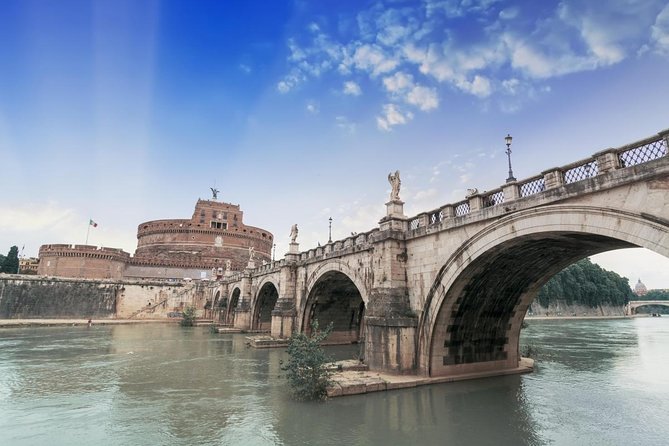
- Explore a mysterious side of Roman history with ghost stories and visits to haunted sites, including where Julius Caesar was assassinated.
- Enjoy a family-friendly experience with passionate guides and personalized tours curated by More of Rome owners.
- Start at Museo Nazionale di Castel Sant’Angelo and end at Campo de Fiori , immersing in Rome’s spooky ambiance.
- Receive excellent reviews averaging 5.0 stars for the tour’s alternative history, knowledgeable guides , and entertaining experience.
Here's some more nearby activities we've reviewed
- Skip the Line: Colosseum, Roman Forum & Palatine Hill Guided Tour
- Global: Esim High-Speed Mobile Data Plan
Tour Highlights
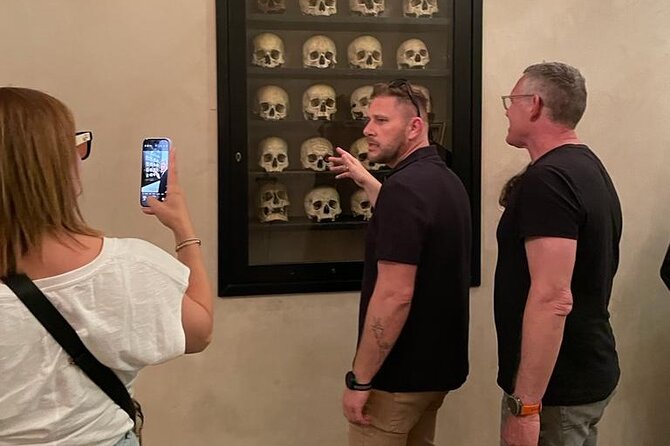
Step into the shadows of ancient Rome and uncover the eerie secrets and ghostly tales on the Dark Side Walking Tour. This family-friendly tour offers a unique experience where visitors can explore haunted stories while exploring the historical streets of Rome.
From the site of Julius Caesar’s assassination to the mysterious Castel Sant’Angelo, you will be immersed in chilling narratives that bring the city’s past to life. The knowledgeable guides lead the way, sharing captivating tales that appeal to both adults and children.
As visitors walk through Rome’s narrow, cobbled streets , they’ll encounter landmarks shrouded in mystery and intrigue. The Dark Side Walking Tour promises an unforgettable journey through Rome’s haunted history.
Spooky Encounters
Venture into the shadows of Rome and prepare to encounter spine-chilling tales of ghostly encounters on the Dark Side Walking Tour. Get set for an eerie adventure filled with ghoulish tales and supernatural sightings as you explore the darker side of Rome’s history.
Here are some hair-raising highlights of what you might experience:
- Listen to the haunting stories of restless spirits said to wander the ancient streets of Rome.
- Visit mysterious locations where supernatural sightings have been reported throughout the centuries.
- Discover the secrets behind Rome’s most famous ghostly legends, including tales of betrayal and revenge.
- Feel a shiver down your spine as you uncover the chilling history hidden within Rome’s historic landmarks.
Guided Exploration
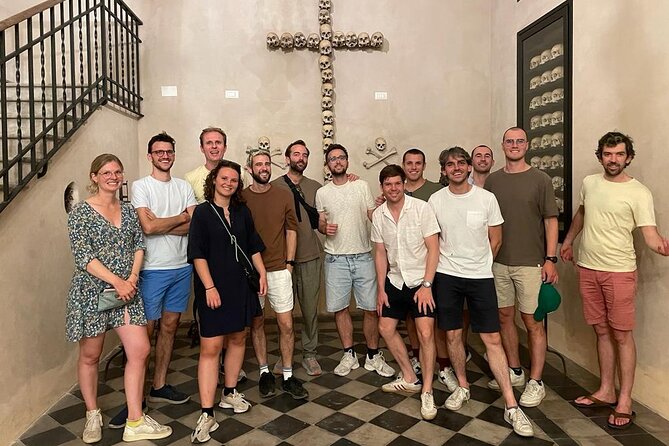
Set out on a captivating journey through the hidden corners of Rome’s history with an expert guide leading the way on the Dark Side Walking Tour.
As you explore Rome’s mysterious past, here are some exploration tips to enhance your experience. Keep an open mind and learn about the historical insights shared by your guide.
Ask questions and interact with the stories to truly connect with the city’s dark side. Pay attention to the details of the landmarks you visit, such as Castel Sant’Angelo, and listen closely to the ghost stories and haunted places you encounter.
Meeting Point Details
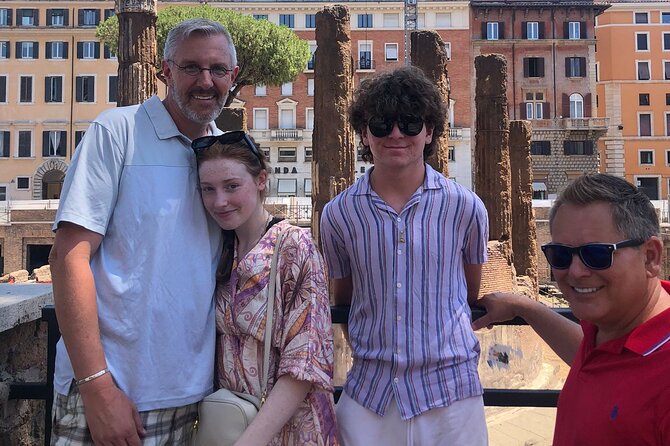
Upon arriving at the meeting point for the Dark Side Walking Tour in Rome, guests will easily spot their guide holding a MORE OF ROME sign near the Museo Nazionale di Castel Sant’Angelo at Lungotevere Castello.
Four Meeting Logistics to Note:
- Guests should aim to arrive 15 minutes early to check-in and meet their guide.
- The meeting point is conveniently located near public transportation for easy access.
- In case of any delays or issues, guests can contact the tour operator directly for assistance.
- Restrooms and cafes are available nearby for any last-minute needs before the tour commences.
End Point Information
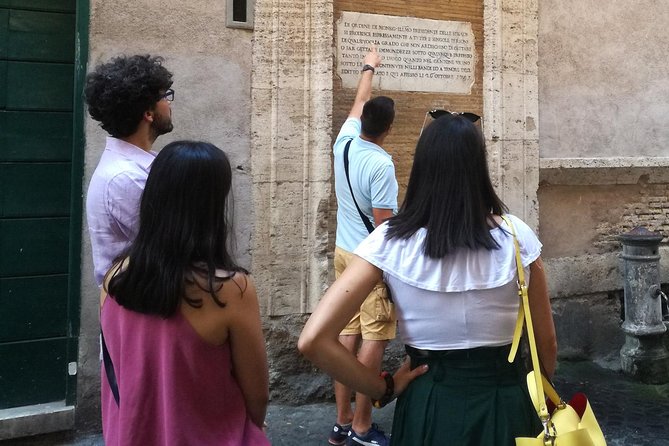
Guests will conclude their eerie exploration at Campo de Fiori , a bustling central square in Rome teeming with a vibrant farmers market, charming eateries , and inviting cafes. Campo de Fiori isn’t only a historical square but also a hub of local cuisine , offering a variety of traditional Roman dishes and international flavors for visitors to indulge in.
After a chilling tour filled with ghost stories and haunted locations, guests can unwind in this lively square, soaking in the atmosphere, sampling delicious street food, or sitting down for a relaxing meal at one of the many restaurants.
The vibrant energy of Campo de Fiori provides a perfect contrast to the mysterious and dark secrets uncovered during the walking tour.
Traveler Reviews
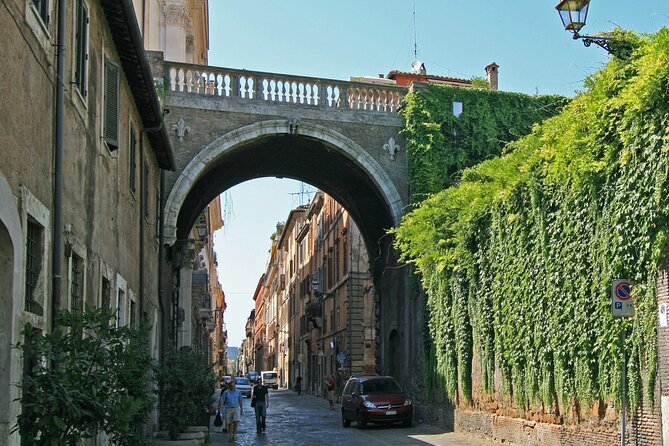
With an average rating of 5.0 from 11 reviews by Viator travelers, the Secrets of Rome – Dark Side Walking Tour has garnered high praise for its alternative history and captivating sights.
Traveler reviews highlight the spine-chilling stories shared by guides, creating a thrilling experience for participants.
Tourists appreciated the unique perspective offered by the guides, providing both tourist viewpoints and local insights into Rome’s mysterious past.
Many guests found the tour to be informative and engaging, with the guides’ knowledge and storytelling abilities receiving particular acclaim.
Booking and Contact Information
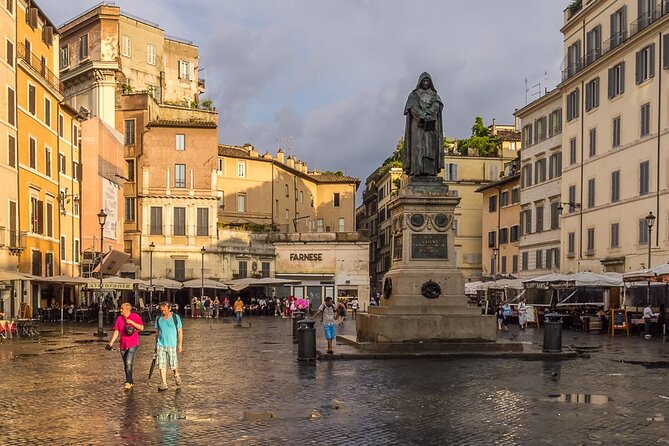
To secure a spot on the Secrets of Rome – Dark Side Walking Tour and to get in touch with the tour operators, travelers can refer to the booking and contact information provided below.
Here's a few more nearby tours and experiences we have reviewed.
- Pompeii Day Trip From Rome With Mount Vesuvius or Positano Option
- Skip-the-Line Group Tour of the Vatican, Sistine Chapel & St. Peters Basilica
- Vatican Museums, Sistine Chapel & St Peter’s Basilica Guided Tour
- Rome: Crypts, Catacombs & Undergrounds Tour With Coach Transfers
- Skip the Line Vatican & Sistine Chapel Tour With Basilica Entry
- Colosseum, Palatine Hill and Roman Forum: Skip-the-Line Ticket (Mar )
Common questions
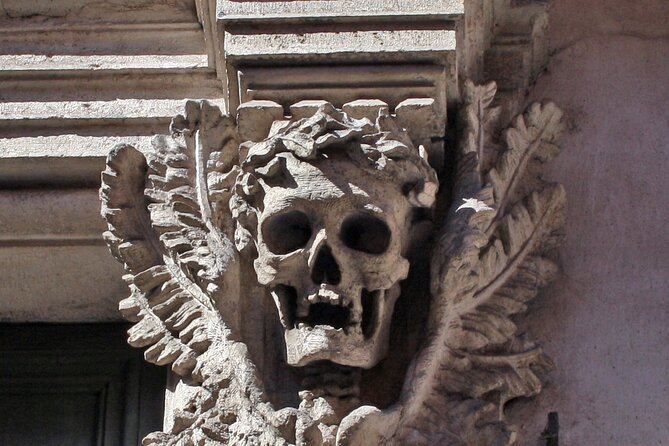
Can Children Participate in the Secrets of Rome – the Dark Side Small Group Walking Tour?
Parental discretion is advised for child participation in the Rome walking tour. Kids can join, but the content may be spooky. Families can explore Rome’s haunted spots together. The tour offers a unique, historical experience suitable for all ages.
Are There Any Age Restrictions for This Tour?
Age restrictions vary for tours, with some being family-friendly and suitable for children. Children can participate in the tour, but it’s advisable to check specific age requirements. Enjoy a spooky exploration of Rome!
Is the Tour Wheelchair Accessible?
The tour does not offer wheelchair access due to accessibility restrictions . It’s essential to consider mobility limitations when planning to join this adventure. The guides are eager to provide a memorable experience for all participants.
Are Photos Allowed During the Tour?
Photos are allowed during the tour. Participants should follow the photo policy and adhere to tour etiquette . Capturing memories is encouraged, but it’s essential to respect the sites, guides, and fellow tour members.
Are There Restroom Facilities Available Along the Tour Route?
Restroom facilities are available along the tour route for convenience. The tour ensures accommodations for essential needs. Visitors can explore worry-free, focusing on absorbing Rome’s mysterious history while enjoying the journey.
Here's more of our most recent tour reviews happening neaby
- Colosseum, Roman Forum and Palatine Hill Tour
- The Best of Rome in a Day Private City Tour By Car
- Sightseeing Walking Tour of Rome By Night: Trevi Fountain & Other Highlights
- The Vatican Private & Skip the Line Tour W/Sistine Chapel
- Colosseum and Roman Forum Private Tour Led by an Archaeologist
- Rome Night Tour With Expert Local Guide
- Private Walking Tour of Rome and a Cooking Class
- Rome Unveiled: Full-Day Journey Through City and Vatican Wonders
- Small-Group Guided Walking Tour of Rome Top Sights
- Civitavecchia Port Private Luxury Transfer
- Private Day Trip From Rome: Bracciano Lake and Surrounding Areas
Uncover the chilling secrets of Rome on the Dark Side Small Group Walking Tour – an experience that will send shivers down your spine and leave you breathless with excitement!
Join Dimitri and Emanuela on a journey through the shadows of the Eternal City, where ghost stories and haunted locations await.
Don’t miss this unique exploration of Rome’s dark side – book your tour now and prepare for a thrilling adventure like no other!
Similar Posts

Tour to Keukenhof, Tulip Farm and Windmill Cruise From Amsterdam
Set out on a journey through the vibrant tapestry of Keukenhof gardens, Tulip Farm, and Windmill Cruise from Amsterdam, where…

Small-Group Afternoon Cairns City Tour With Harbour Dinner Cruise
Travelers looking to explore Cairns in a unique way often opt for the Small-Group Afternoon Cairns City Tour With Harbour…
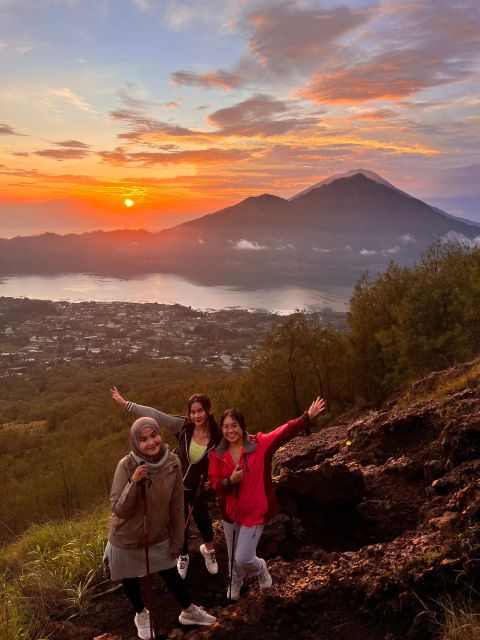
Mount Batur Sunrise Hike With Breakfast
As the cool morning breeze kisses their cheeks, hikers ascending Mount Batur are reminded of life’s ephemeral nature, much like…

Private Transfer in Fort Lauderdale (FLL & FXE) Airport/Home/Hotel/Work
When arriving at Fort Lauderdale Airport, imagine being whisked away seamlessly to your destination with a private transfer service tailored…
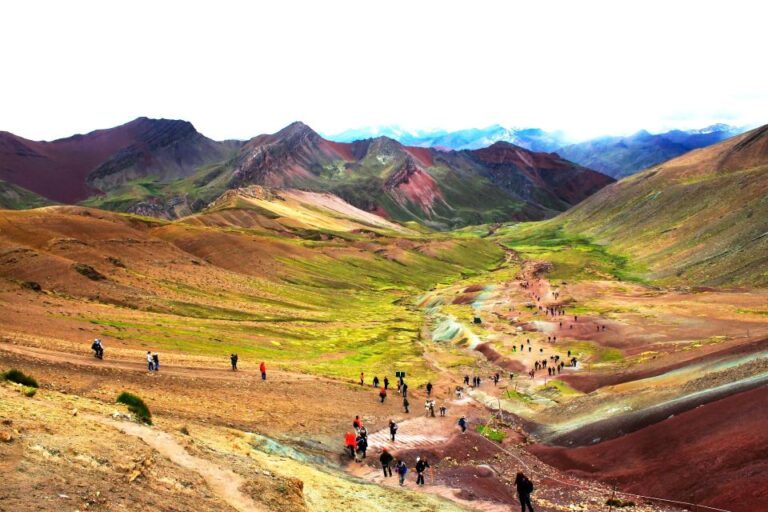
Cusco: Full-Day Rainbow Mountain & Red Valley Trekking Tour
Traveler Sarah from New York had always dreamed of exploring the vibrant landscapes of Peru, and the Full-Day Rainbow Mountain…

Best Seller Halong Bay Day Cruise: Sung Sot Cave, Titop, Kayaking
With over 1,000 reviews and an impressive 5.0 overall rating, the Best Seller Halong Bay Day Cruise: Sung Sot Cave,…

30 Dark Tourism Destinations and How to Visit
By: Author Zachary Friedman
Posted on Last updated: March 1, 2024
Categories Travel Destinations
Home » Travel » Travel Destinations » 30 Dark Tourism Destinations and How to Visit
Many of us have a natural morbid curiosity. Death, disasters, atrocities, and destruction fascinate us. Every year, millions of people travel to some of the darkest and most tragic sites on earth to satisfy that curiosity as well as to gain a deeper understanding of the events that took place there. This is called dark tourism. In this guide, we’ll outline some of the most popular dark tourism destinations and explain how to visit them. We’ll also explain exactly what dark tourism is and talk a bit about the ethics, controversies, and motivations of dark tourism.
Personally, I’m a big fan of dark tourism. Over the years, I’ve visited many of the dark tourism sites on this list. In this guide, I’ll share my experience.

Table of Contents
- Auschwitz-Birkenau Memorial, Poland
- Chernobyl Nuclear Disaster Site, Ukraine
- Choeung Ek Killing Fields and S-21, Cambodia
- September 11 Memorial and Museum, New York
- Hiroshima Peace Memorial Park and Museum, Japan
- Kigali Genocide Memorial, Rwanda
- Pompeii, Italy
- Slave Castles, Ghana
- Sedlec Ossuary, Czech Republic
- Alcatraz Island, San Francisco
- Suicide Forest (Aokigahar), Japan
- Fukushima, Japan
- Robben Island, South Africa
- Pearl Harbor, Hawaii
- The Colosseum, Rome
- Mount St. Helens, Washington
- Anne Frank House and Museum, Amsterdam
- Various Nuclear Test Sites
- The Catacombs of Paris
- Warsaw Ghetto, Poland
- Perm-36 Gulag, Russia
- Cremations on the Ganges River in Varanasi, India
- WWII memorials and museums in Berlin, Germany
- Communist Leader Mausoleums
- Somme Battlefield, France
- Verdun Battlefield, France
- D-Day Beaches and Memorials in Normandy
- Antietam National Battlefield, Sharpsburg, Maryland
- Cu Chi Tunnels, Vietnam
What is Dark Tourism?
Dark tourism is a relatively new term for a form of tourism that involves travel to a site where death, tragedy, disaster, violence, atrocity, or suffering took place. This could include sites of genocide, assassination, natural disaster, war, terrorism, man-made disaster, etc. Usually, dark tourism sites have some kind of historical significance. They could also be the site of a recent or ongoing tragic event. Dark tourism is also called black tourism, morbid tourism, and grief tourism.
A few of the most well-known and popular dark tourism sites in the world include the ruins of Pompeii, Auschwitz concentration camp, the site of the Chornobyl nuclear disaster, the Paris Catacombs, Gettysburg, Ground Zero, and the 9/11 memorial in New York. In each of these sites, death, suffering, tragedy, or disaster took place.
Most people visit dark tourism sites for educational purposes. These sites usually have interesting histories. Some people visit because these sites pique a morbid curiosity. Others just want to witness large scale destruction and damage. Everyone has their own motivation.
There are different types of dark tourism as well. For example, dark tourism and heritage tourism are sometimes closely related. For example, someone may choose to visit Holocaust sites to learn about the events that their ancestors experienced. Descendants of slaves may choose to visit slavery heritage sites. Some consider this a form of dark tourism as well.
To consider someone a dark tourist, they must visit the site for dark tourism purposes. Some sites have a dark element but aren’t exclusively visited for dark tourism purposes. For example, if you visit Mount St. Helens to go for a hike, you’re not a dark tourist. If you visit to learn about the volcanic eruption and the damage it caused, you are a dark tourist.
Dark Tourism Destinations
1. auschwitz-birkenau memorial and museum, poland.

Located outside of Krakow, Poland, Auschwitz was the largest and most deadly of the Nazi concentration camps. Between 1.1 and 1.6 million men, women, and children were murdered here during the Holocaust. Auschwitz is one of the largest mass murder sites in the world.
Today, the site symbolizes genocide and the evil acts that humans inflict upon one another. It also acts as a valuable education tool to help prevent atrocities such as the Holocaust from happening again.
Auschwitz is actually a series of 40 concentration camps rather than one large camp. Auschwitz I is the older and smaller camp where political prisoners were held. Here, you’ll see a terrifying exhibition of some of the inmates’ possessions including piles of suitcases, shoes, and human hair.
Auschwitz-Birkenau, which is located a couple of miles down the road, is a much larger concentration camp and extermination camp. Here, you’ll find the ruins of the infamous gas chambers, barracks with wooden shelves where prisoners slept, and the train track which was used to haul thousands of people into the camp.
Auschwitz has become a mass tourist site seeing over 2 million visitors per year and over 60 million visitors since the site opened in 1947. This is probably the world’s biggest and most well known dark tourism site. The Auschwitz Memorial is free to enter but you should book in advance. Only a limited number of tickets are available per day because the site is so popular.
2. Chernobyl Nuclear Disaster Site, Ukraine

On April 26, 1986, the world’s worst nuclear meltdown took place at the Chernobyl nuclear power plant near Pripyat, Ukraine. This disaster caused the death of around 4,000 individuals from radiation-related illness as well as the displacement of over 300,000.
The area is still not safe for people to inhabit, even though some have moved back into their villages anyway. In fact, scientists believe it could take 20,000 years before the exclusion zone is completely safe. The radiation has dissipated enough for tourists to make short visits on guided tours.
Several tour companies offer day trips and multi-day trips to Chernobyl from the nearby city of Kyiv. During the tour, you’ll see the radiation-contaminated Red Forrest and eerie abandoned buildings including the famous Pripyat Amusement Park and a Kindergarten. You’ll also learn about the impact the disaster had on the region.
Keep in mind that there is still a risk of radiation poisoning when visiting the Chernobyl exclusion zone. Radiation levels are still hazardous in much of the zone. Your guide will explain the safety precautions you must take and guide you through the areas that are safe enough to visit.
Chernobyl is one of the world’s most famous and popular dark tourism sites. The recent HBO miniseries, Chernobyl, greatly increased the popularity of the area. Following the release of the show, tourism increased by 30%.
Note: Currently, it’s not possible to visit this site. Hopefully, it will be possible to visit again in the near future.
3. Choeung Ek Killing Fields and Tuol Sleng Genocide Museum (S-21), Cambodia
The Khmer Rouge regime came into power after the Cambodian civil war ended in 1975. The new government was called the Communist Party of Kampuchea. Their leader was prime minister Pol Pot.
Immediately following the end of the war, the Cambodian genocide began. From 1975 to 1979, between 1.7 and 2.5 million people were killed at 300 sites throughout the country. These sites are known as killing fields.
The most famous of these killing fields is Choeung Ek, which is located about 11 miles outside of Phnom Penh, the capital of Cambodia. It is estimated that around 17,000 men, women, and children were killed at this site. Many were killed violently with knives, scythes, bats, and bayonets. This is the main memorial for the Cambodian genocide.
At this site, you’ll see a memorial Buddhist stupa made of glass. Inside the stupa, there are 5,000 human skulls. Many of the displayed skulls are catastrophically damaged, showing the brutal manner in which the victims were killed. The site also includes a mass grave that contains the remains of almost 9,000 people that were exhumed from the surrounding area. Human bones still litter the entire site. Occasionally fragments wash up after heavy rain.
Another famous Cambodian Genocide site is the Tuol Sleng Genocide Museum or S-21. This museum is located in Phnom Penh. Originally, this site was built as a secondary school but was converted into a prison by the Khmer Rouge. Around 20,000 people were imprisoned here during Pol Pot’s reign. Many were tortured and killed. Here, you’ll see prison cells, photos of victims, as well as an exhibit that documents the events of the Cambodian genocide.
4. National September 11 Memorial and Museum, New York

This New York City memorial and museum was built to commemorate and honor the 2,977 people who died in the September 11, 2001 terror attacks as well as the six people who died in the 1993 World Trade Center bombings. The memorial sits on the site where the twin towers once stood.
The main memorial, called Reflecting Absence, consists of two 1-acre pools that occupy the exact footprints where the Twin Towers stood. Each pool features a large waterfall. Bronze parapets with the name of each victim etched in surround the pools. The September 11 Museum, located underground, contains thousands of images, artifacts, recordings, and videos. The exhibit tells the complete story of the events of 9/11.
This site is fairly controversial. Partly for the high price of entry ($24) but mostly for the fact that the remains of over 1000 victims were placed in a tomb in the bedrock under the museum. Many people find this disrespectful. Even so, the 9/11 Memorial is one of the world’s most popular dark tourism sites. Over 6 million people visit this memorial per year.
5. Hiroshima Peace Memorial Park and Museum
This memorial and museum commemorate and honor the city of Hiroshima and the 140,000 people who died when the United States dropped an atomic bomb on the city on August 6, 1945. It also memorializes the world’s first nuclear attack. The aim is to educate people about the danger of nuclear weapons as well as to promote peace.
The atom bomb, codenamed “Little Boy,” detonated 600 meters above the busiest part of downtown Hiroshima. The explosion essentially leveled the area except for a few ruins. This event marked the beginning of the end of WWII. Japan surrendered on August 15, 1945. The park was built on the site of the bombing. Today, the Hiroshima Peace Memorial Park contains a number of monuments as well as a museum and a lecture hall.
Hiroshima Peace Memorial Museum is the main feature of the park. The museum educates visitors about the events leading up to the bombing as well as the catastrophic effect the bomb had on the city. You’ll see photos and artifacts from the bombing. A major section of the museum is dedicated to the stories of the victims and survivors.
The A-Bomb Dome is the second most important site in the park. This is the ruins of the Hiroshima Prefectural Industrial Promotion Hall. Today, it’s just a shell of a building. This building is significant because it is one of the only buildings that survived the blast. Most structures in Hiroshima were built from wood and burned up in fires that the bomb started. This building was also just 150 meters from the hypocenter of the blast. It has been designated a UNESCO World Heritage Site.
A few more significant points of interest in Hiroshima Peace Memorial Park include Children’s Peace Monument, Peace Flame, Peace Bells, Peace Pagoda, Gates of Peace, and Atomic Bomb Memorial Mount. You could easily spend half a day wandering around the park viewing the various monuments and memorials.
3 days after the bombing of Hiroshima on August 9, 1945, The United States bombed the city of Nagasaki in a second nuclear attack. Today, you’ll find a number of memorials and museums including the Atomic Bomb Museum, Peace Park, Oka Masaharu Memorial Peace Museum, and more.
6. Rwanda Genocide Sites (Kigali Genocide Memorial and Murambi Genocide Memorial)
In 1990, a rebel group of Tutsi refugees called the Rwanda Patriotic Front (RPF) invaded Rwanda from Uganda. This started the Rwandan Civil War. President Juvénal Habyarimana signed peace accords in 1993. The following day, the president was assassinated. Genocidal killings of Tutsi people began soon after and the civil war resumed.
The Rwandan genocide lasted from April 7 to July 15, 1994. During that time 500,000-1,000,000 people were killed. This includes about 70% of Rwanda’s Tutsi population. The genocide ended when the RPF captured Kigali and gained control of the country. The government and genocidaires were forced into Zaire (now the Democratic Republic of the Congo).
Today, there are a number of genocide memorials located throughout the country. The largest and most visited is the Kigali Genocide Memorial Centre. The remains of an astonishing 250,000 people are interred at this site. The attached museum includes three exhibits. The first documents the events of genocide from start to finish. The second exhibit is a memorial to the children who died. It includes photos and details about their lives, things they liked, and the way they died. The third exhibit covers genocide around the world.
The Murambi Genocide Memorial (Murambi Technical School), located in southern Rwanda is one of the darkest dark tourism destinations on the planet. Here, around 50,000 Tutsi men, women, and children were murdered by Hutu Interahamwe militiamen in April of 1994.
The Tutsis were told that they could safely shelter at the school and that the French military would protect them. This turned out to be a trap. After being starved for several days to weaken them, they were attacked and killed. Only 34 people survived the attack and escaped. At Murambi, the remains of 800 people are displayed partially decomposed and preserved by lime.
7. Pompeii, Italy

This ancient Roman city was wiped out when nearby Mount Vesuvius erupted in 79 AD. Historians estimate that about 2,000 people died in the disaster. The thick layer of ash and pumice that covered the city preserved this little slice of ancient Rome.
At the ruins, you can see beautifully preserved artwork, pottery, casts of people who died, houses, an amphitheater, and more. Pompeii is a UNESCO World Heritage site and is one of Italy’s most popular tourist destinations with over 2.5 million visitors per year.
Some people question whether or not Pompeii is actually a dark tourism site due to the age of the site. After all, the eruption occurred nearly 2000 years ago. In my opinion, Pompeii is absolutely a dark tourism site due to the large scale death and destruction that happened here. The age of the site is irrelevant.
8. Slave Castles, Ghana (Cape Coast Castle and Elmina Castle)
During the colonial period of West Africa, the British, Dutch, and Portuguese built around 40 castles or forts along the Gold Coast. The Europeans originally used these castles as trading posts for timber or gold.
During that time, African slaves were in high demand in the Americas. The European traders quickly found that the slave trade was more profitable.
They modified their forts to hold as many slaves as possible. Usually in an underground dungeon. African slavers would capture slaves inland then sell them to the Europeans who lived in the castles on the coast. The slaves stayed in the castles until they were shipped across the Atlantic to the Americas.
Living conditions for the slaves were horrible. Slavers shackled and packed the slaves into the castle’s dungeons. There was very little light or ventilation. There was no water or sanitation so the floors were covered in waste. Many became ill. The slaves lived in these conditions for up to three months before being shipped across the Atlantic.
Today, dark tourists visit these castles to learn about the horrors of the slave trade. Two of the most significant castles to visit include Elmina Castle and Cape Coast Castle. Both are located in Ghana. Guided tours are available.
Elmina Castle was the first European trading post and is the oldest European building in Sub Saharan Africa. The Portuguese built the castle in 1482. Today, it is a UNESCO World Heritage Site. Here, you can see the famous ‘Door of No Return’ where slaves exited the castle before boarding ships to Brazil and other Portuguese colonies. You’ll also see the dungeon where the slaves were held as well as the living quarters for the European slavers, who lived on the upper floors of the castle.
Cape Coast Castle was built by Swedish traders in 1653. Over the years, the castle changed hands multiple times until it came into British possession. Here, you can see the dungeons where slaves were held and cannons that were used to defend the fort. In 2009, President Obama visited Cape Coast Castle during his visit to Ghana.
9. Sedlec Ossuary, Czech Republic
This small Roman Catholic chapel is located in a cemetery in a suburb of the city of Kutná Hora in the Czech Republic. Here, you’ll find the remains of 40,000-70,000 people. Initially, the remains were moved from the cemetery into the basement of the chapel to solve an overcrowding problem that was caused by the plague in the 14th century.
In 1870, a local artist named František Rint rearranged the piles of bones into artwork. The most impressive piece is a massive chandelier in the center of the chapel that is made entirely from human bones. Supposedly it contains at least one of every bone in the human body.
Another interesting piece is a large coat of arms made from bones. In the corners of the chapel, you’ll find large stacks of bones. There are cabinets filled with damaged skulls of those who were killed violently in war. The artist also signed his name in bones.
You can visit Selded Ossuary as a day trip from Prague. It’s easy to visit independently by train. Organized tours are available as well. The chapel is pretty small. It only takes 20 minutes or so to see the whole thing. The place gets pretty crowded as it receives over 200,000 visitors per year.
10. Alcatraz Federal Penitentiary, San Francisco

Also known as The Rock, Alcatraz Federal Penitentiary was a maximum-security prison from 1934-1963. It is located on an island in the San Francisco Bay, 1.25 miles offshore. During the 29 years that the prison operated, some of the hardest criminals of the day served time here including the infamous Al Capone, Machine Gun Kelly, Henri Young, and ‘the Birdman of Alcatraz’, Robert Stroud.
For punishment, prisoners were sent to solitary confinement, known as ‘the hole’ at Alcatraz. These inmates got one shower and one hour of exercise per week. Almost equally punishing for some, the prison sits close enough to the mainland that prisoners could see people going about their lives on the outside.
Today, Alcatraz is San Francisco’s most popular tourist attraction with up to 1.5 million visitors per year. The National Park Service manages the island. After arriving at the island by boat, you can take a tour of the prison. You’ll see the prison cells, learn about the dark history of the island, and hear stories of former inmates. Much of the prison remains the way it was while the prison was in operation.
11. Suicide Forest (Aokigahar), Japan
This forest, located to the Northwest of Mount Fuji, is famous for being one of the most popular suicide site in Japan. In 2003, a record was made when 105 bodies were found in the forest. In 2010, over 200 people attempted suicide here with 54 of those being successful.
The most common methods of suicide used are hanging and drug overdose. Because the suicide rate is so high here, Japanese officials installed a sign at the entry to the park which urges suicidal people to seek help.
Part of the reason for the popularity of this forest as a suicide site is that the area has long been associated with death in Japanese culture. The forest is said to be haunted by the yūrei, which are spirits that can’t leave our world.
Here, visitors can roam about the many trails that wind throughout the 30 square kilometer forest. This is an excellent place to enjoy the solitude of the dense forest. Tours are available as well.
Some visitors come here to see if they can spot a body. As you can imagine, this is a very controversial form of dark tourism. For example, YouTuber Logan Paul was criticized for filming a video of a man who had recently committed suicide here in 2018.
12. Fukushima, Japan
On March 11, 2011, an earthquake off the east coast of Japan triggered a tsunami that flooded the reactors at Fukushima nuclear power plant and caused an electrical grid failure. The reactors lost their cooling which led to three nuclear meltdowns at the plant. 154,000 people had to be evacuated. Many were never able to return to their homes.
Today, there is a 20 km exclusion zone surrounding the nuclear plant to protect people from radiation exposure. In 2018 tours to visit the exclusion area began. In 2020, The Great East Japan Earthquake and Nuclear Disaster Memorial Museum opened. On the tour, you’ll see abandoned structures and witness the effects that the disaster had on the region.
13. Robben Island, South Africa
Robben Island, located in Table Bay, north of Cape Town, was used as a prison from the colonial times of the late 1600s until 1996. The prison gained notoriety during the apartheid era of South Africa. It held political prisoners between 1961 and 1991.
The most famous prisoner was political revolutionary, Nobel Peace Prize recipient, and president of South Africa, Nelson Mandela. He served 18 of his 27-year imprisonment on Robben Island before his release in 1990. in 1994, South Africa elected Mandela as the first president. A total of three former inmates went on to become South African presidents including Kgalema Motlanthe and Jacob Zuma.
Conditions in the prison were incredibly harsh. Prisoners were held isolated from one another in small cells. The prison was segregated by race. Food rations were small and communication with the outside world was limited. Prisoners were also forced to do hard labor in a lime quarry located on the island.
Today, Robben Island is a UNESCO World Heritage Site and a South African National Heritage Site. The only way to visit Robben Island is on a guided tour. The tour leaves from Cape Town and lasts for about 3.5 hours. The guides are all former prisoners. They take you around the prison and share their first-hand stories about their time there. You’ll see the lime quarry where the prisoners were forced to work as well as Nelson Mandela’s prison cell.
14. Pearl Harbor, Hawaii
On December 7, 1941, the Imperial Japanese Navy Air Service surprise attacked the United States naval base at Pearl Harbor, Hawaii. The goal of the attack was to prevent the United States Navy fleet from interfering with the Japanese military plans to expand throughout Southeast Asia. If Japan crippled the United States fleet was crippled, they could invade and conquer US and British held territories such as the Philippines, Guam, Singapore, Malaysia, and Hong Kong, as well as other small islands of the Pacific.
The Japanese launched a massive attack with 353 aircraft which took off from six aircraft carriers. They sank 4 of the 8 battleships stationed at Pearl Harbor. They seriously damaged the other four. 188 aircraft were also destroyed in the attack 159 were damaged. The attack killed 2,403 Americans and injured 1,178. The attack also damaged or destroyed a considerable amount of the base’s infrastructure including a power station, piers, various buildings, and more.
The most significant loss was the battleship USS Arizona. It suffered a direct hit to an ammunition magazine which exploded and caused the ship to sink almost instantly. 1,000 sailors sank with the ship.
The attack on Pearl Harbor dragged the United States into World War II. The day after the attack, Japan declared war on the United States. The next day, the United States declared war on Japan. Three days later, Germany and Italy both declared war on the United States.
Today, there are a number of museums and memorials at Pearl Harbor that commemorate the attack. The main site is the USS Arizona memorial. This memorial straddles the sunken ship and is accessible only by boat. Inside, you’ll see a number of exhibits including one of the ship’s anchors, a shrine with the names of all of those who died as well as some plaques with information about the attack. There is also an opening in the floor where you can view the deck of the ship underwater. Onshore, there is also a museum that outlines the events leading up to the attack and the attack itself.
Nearby, you can also view the USS Missouri Memorial, USS Utah Memorial, USS Oklahoma Memorial, Pacific Aviation Museum, and USS Bowfin Museum.
15. The Colosseum, Rome

Built in Ancient Rome between 72-80 AD, the Colosseum is one of the oldest and most recognizable dark tourism sites. At the time, it was the largest amphitheater ever built with a capacity of 50,000-80,000 spectators. The Colosseum, also known as the Flavian Amphitheatre, hosted a number of dark and violent events including gladiatorial events, executions, animal hunts, and battle re-enactments.
The most famous of these events were the gladiatorial contests. People and animals brutally battled to the death for the entertainment of thousands of spectators. Most gladiators were slaves, criminals, or prisoners of war but some volunteered to seek fame and fortune.
Exotic wild animals including lions, hippos, rhinos, elephants, bears, tigers, crocodiles, etc. were brought in from Africa and the Middle East. These animals were used for hunts or battles. In some cases, people were fed to lions.
Over the course of the 400 years that these gladiatorial events took place, historians estimate that around 400,000 people died in the Colosseum. Some people consider these events the earliest form of dark tourism.
Today, the Colosseum is one of the top tourist destinations in Rome and the world. Around 7 million people visit this site per year. There are a number of guided tours available. You’ll see the underground level where the gladiators prepared to fight, the arena floor where the gladiatorial fights took place, areas where the animals were kept, and artwork.
16. Mount St. Helens, Washington
The 1980 volcanic eruption of Mount St. Helens killed 57 people and caused a great deal of destruction to the mountain and surrounding area including the largest landslide in recorded history. The eruption was so violent that the mountain’s elevation decreased by 1300 feet. The top completely blew off.
Many tourists come to visit the area each year. Today, you can see tree stumps and dead trees that still stand around the blast site. There is a visitor center with an exhibition about the eruption. In the visitor center, they also have a small movie theater that shows a short documentary about the event. The surrounding state park offers plenty of hiking, camping, climbing, and other recreational activities.
17. Montserrat
This volcanic island in the Caribbean is sometimes called a modern-day Pompeii. The Soufriere Hills Volcano became active in the mid-1990s and slowly covered the former capital of Plymouth in ash. The town was evacuated in 1997 just before a major eruption covered much of it.
The volcano is still very active today, periodically spewing ash, smoke, and gasses across 1/3 of the island. Occasionally pyroclastic flows cover more of the island’s land. Travelers can hike to a lookout point to view smoke spewing from the volcano and maybe get a glimpse of Plymouth. It is also possible to view the volcano and town by boat. It is unsafe to visit the town of Plymouth at this time.

16. Anne Frank House and Museum, Amsterdam
In this famous canal house Anne Frank, her family, and four others hid from Nazi persecution for 761 days. They quietly lived in a hidden part of the house called the Secret Annex. Anne Frank is famous for keeping a diary of her daily thoughts and experiences during her days in hiding during World War II.
Sadly, Anne Frank and the others hiding in the Secret Annex were betrayed by an unknown informant and discovered by the Nazis on August 4, 1944. The Nazis split them up and moved them to various concentration camps. Anne Frank died in Bergen-Belsen concentration camp in February of 1945 when she was just 15 years old. Anne’s father Otto, who survived the Holocaust, discovered his daughter’s diary after the war and published it in 1947.
The canal house where the two families hid is a now museum that attracts up to 1.2 million visitors per year. Here, you can walk through the Secret Annex where Anne Frank and her family hid. The original diary is on display in the attached museum. The museum also includes a permanent exhibit about the life of Anne Frank and her experience during the war.
19. Nuclear Test Sites
Since nuclear testing began in 1945, 8 countries have detonated around 2056 nuclear bombs at dozens of test sites around the world. A few nuclear test sites that you can visit include:
- Semipalatinsk Test Site (The Polygon)- Semipalatinsk was the Soviet Union’s primary nuclear test site from 1949-1991. It is located on the steppe of northeastern Kazakhstan. More nuclear weapons detonated here than anywhere else on the planet. Beginning in 2014 parts of the area have opened up for tourism. There isn’t all that much to see here outside of some massive craters and some concrete towers and bunkers that housed instruments to measure the blasts.
- Nevada Test Site- This site was the United States’ main nuclear testing site from the time it was established in 1951 until nuclear testing ended in 1992. The site is located about 65 miles to the northeast of Las Vegas. Here, you can see a number of large craters in the desert where nuclear weapons were detonated for testing purposes. Monthly public tours are offered but are often fully booked months in advance. This is a difficult place to visit.
- Bikini Atoll, Martial Islands- This was one of the United States’ main nuclear test sites. Between 1946 and 1958, 23 atomic bomb tests were performed here. The blasts turned out to be more destructive than anticipated and resulted in significant contamination to the surrounding area. Probably the biggest attraction for tourists here is Scuba diving the 10 ships that were sunk during nuclear tests. This is a risky area to visit due to the significant levels of radiation that still exist.
20. Catacombs of Paris, France

This network of underground ossuaries underneath the city of Pairs holds the remains of around 6 million people. The tunnels were originally mine tunnels. The Paris Catacombs were built to solve the problem of the city’s overflowing cemeteries. The dead were crowding the living. Starting in 1786, the city began transporting human remains from the city’s cemeteries into the underground tunnels by covered wagon during the night. The catacombs open to tourism in 1867.
Today, the Catacombs are one of the more popular tourist destinations in Paris. You can book a guided tour and wander through the labyrinth of bone filled tunnels and view the millions of bones stacked neatly throughout. Around 300,000 people visit this site per year. It is only accessible by tour.
21. Warsaw Ghetto, Poland
Ghettos were segregated neighborhoods where Jewish people were forced to live while under Nazi occupation during WWII. The largest of these was the Warsaw Ghetto. The area actually consists of two smaller ghettos with a footbridge between them. At its peak, approximately 460,000 people lived in Warsaw Ghetto.
During the Uprising the ghetto was almost completely destroyed. Today, you can visit the area and view a small number of streets and buildings that survived. The monument called ‘The Footbridge of Memory’ stands at the site of the original footbridge.
22. Perm-36 Gulag, Russia
Following the Bolshevik Revolution, the Soviet Union built a large system of forced labor camps to imprison ‘enemies of the state.’ These included government officials, military members, and regular citizens. Anyone who was anti-communist or anti-Stalin was imprisoned. These camps were known as gulags. Millions of people were held in these camps and forced to perform backbreaking work in extremely brutal conditions.
Perm-36 is the only remaining Soviet gulag. It is located about 60 miles from the Russian city of Perm in the Western Ural Mountains. The camp operated from 1946-1987. Perm-36 is unique because it was not closed after Stalin’s death in 1953. This is one of the only gulags that was not demolished after the Soviet Union collapsed in 1991.
When Perm-36 opened, it was used as a forced labor camp for regular criminals. In later years, the camp housed political prisoners. The prisoners were forced to do logging work. Some political prisoners lived in 24 hour closed cells. Perm 36 was considered the harshest political camp in the Soviet Union.
Today’s site operates as a museum and memorial called The Museum of the History of Political Repression Perm-36. It opened to the public in 1995. Here, you’ll see the wooden barracks that the prisoners built, various prison buildings, and an exhibit about the gulag system and the prisoners. You’ll also learn about the economic benefit that the gulag system created for the Soviet Union.
23. Cremations on the Ganges River in Varanasi, India

Varanasi is a holy city located on the Ganges river in Uttar Pradesh, India. The city has become a popular dark tourism destination for its famous Hindu cremation ceremonies that take place on the banks of the river. In the Hindu religion, people believe that cremation on the banks of the Ganges river breaks the cycle of reincarnation so they can achieve salvation. Along the river, dozens of cremations take place out in the open every day.
The bodies are placed atop piles of wood and set on fire until they turn to ash. The ashes are then scattered in the Ganges River, which is considered a holy site in the Hindu religion. Poor families who cannot afford a cremation sometimes release the entire body of their loved one in the river to decompose naturally. Some terminally ill people travel to Varanasi so they can die and be cremated in the holy city.
Tourists are welcome to view and experience these cremation ceremonies. When you arrive at the famous ghats on the bank of the river in Varanasi, you’ll clearly see the cremation sites. Just look for the smoke. You’ll see open areas with large fires and piles of wood sitting around. The cremations take place here.
For a few dollars, you can hire a guide to walk you through the cremation site and explain how the process works. There are multiple cremations taking place simultaneously at all hours of the day. You can walk right up and see the cremation and feel the heat from the fire and smell the smoke.
As you can imagine, this is a fairly controversial form of dark tourism. After all, you are essentially attending a cremation for touristic purposes as the family grieves of the loss of their loved one. Some view this as voyeuristic. It’s up to you to decide whether or not this form of dark tourism is ethical.
24. Berlin, Germany

Berlin is one of the darkest cities on earth. It was the capital of Nazi Germany, one of the world’s most evil regimes. Next, it became the most significant city in the cold war. It was also the capital of the socialist single-party regime of the former GDR. As a result, Berlin is packed with dozens of dark tourism sites. A few of the most popular ones include:
- Memorial to the Murdered Jews of Europe (the Holocaust Memorial)- This memorial is to the Jewish people murdered during the Holocaust. It contains 2,711 concrete slabs ranging in height from .2-4.7 meters. The slabs are arranged in a grid pattern over a 19,000 square meter site. Below the memorial is an information center that contains the names of 3 million Holocaust victims as well as photographs and letters. This memorial is quite controversial. Partly because it is so vague. There is no mention of Nazi Germany or the Holocaust on the memorial itself or in the official name of the memorial. People also use the site as a recreational area, sitting or standing on the pillars. Many consider this to be disrespectful. Due to its size and design, the memorial is difficult to defend from vandals.
- Berlin Wall- Between 1961 and 1989, this concrete barrier divided West Berlin from surrounding East Germany. The German Democratic Republic (East Germany) constructed the wall to prevent East Germans from defecting to the west. The four-meter tall wall extended 155km (96 miles) and cut through 55 streets. Today, you can see several small sections of the wall still standing in the city. The largest is is a 1.4 km section that is part of the Berlin Wall Memorial. Here, you can see the graffiti on the west side and learn about the historical significance of the wall.
- Checkpoint Charlie Museum- Checkpoint Charlie is the most well-known crossing between East and West Berlin. The original guardhouse was preserved and today is part of the Checkpoint Charlie museum. Here, you can see exhibits about the Berlin Wall, the Cold War, and some famous escape attempts.
- Jewish Museum- Designed by architect Daniel Libeskind, the Jewish Museum is one of Germany’s best and most popular museums as well as one of Berlin’s most striking landmarks. Here, you’ll find thousands of artifacts, photos, religious objects, and archives that document the struggle of the German Jewish people from the Middle Ages to the present time. The museum also houses a massive library and hosts various events throughout the year.
- Topography of Terror Museum- This museum is located on the site of the Gestapo secret police and SS headquarters. Allied bombings destroyed the original building in 1945. After many years of delay, the museum opened in 2010. The main exhibit focuses on policing under Nazi rule. You’ll see photos, documents, short films, and artifacts that show the crimes that the SS and Gestapo committed throughout Europe. The grounds of the museum also contain some historic artifacts including a large section of the Berlin Wall. You’ll also see an excavated trench that exposes the cellar wall, where political prisoners were kept, tortured, and ofttimes executed.
- DDR Museum- This newer museum outlines life in East Berlin under communist rule with a hands-on approach. Here, you’ll see a recreation of an interrogation room, prison cell, and an apartment. You can try on clothing and watch television from the era. The exhibit covers food, music, daily life, education, architecture, and more. You’ll also learn about the mass surveillance conducted during the time. This is a private museum and is one of Berlin’s most popular.
25. Communist Leader Mausoleums
For whatever reason, communists love to embalm their leaders after they die and put the bodies on public display. A few famous mausoleums you can visit include:
- Lenin Mausoleum- This mausoleum is located in the Red Square in the center of Moscow. Inside, you can view the embalmed corpse of the Soviet leader Vladimir Lenin. The body has been on public display since shortly after his death in 1924. The mausoleum is open to the public and free to enter. Stalin’s body was put on display here from 1953-1961 but was removed and buried near the mausoleum.
- Ho Chi Minh Mausoleum- This mausoleum is located in Ba Dinh Square in Hanoi, Vietnam. Inside, you can view the embalmed body of Vietnamese revolutionary and president Ho Chi Minh, who died in 1969. The body is kept in a dimly lit glass case which is heavily guarded by military honor guards. The mausoleum is open to the public.
- Mausoleum of Mao Zedong- This large mausoleum, also known as Chairman Mao Memorial Hall, is located in the center of Tienanmen Square in central Beijing. Here, you can view the embalmed remains of Mao Zedong, who served as the Chairman of the Communist Party of China from 1945-1976. Interestingly, Chairman Mao wanted to be cremated. The mausoleum is open to the public.
- Kumsusan Palace of the Sun (Kim Il Sung Mausoleum)- This absolutely massive palace is located in the North Korean capital of Pyongyang. The building was intended to be the official residence of Kim Il Sung but was converted into a mausoleum when he died in 1994. Inside, you can view the embalmed remains of North Korean founder Kim Il Sung as well as his son and former leader of North Korea, Kim Jong Il. Both bodies lie inside of glass sarcophaguses. The mausoleum is open to the public. Foreigners can only enter the palace when they are on an official government tour.
26. Somme Battlefield, France
The Battle of the Somme was a WWI battle fought between the French Third Republic and British Empire against the German Empire. The battle took place between July 1 and November 18, 1916. Over three million men fought in the Battle of the Somme. One million were killed, injured, or went missing, making this the most bloody battle of WWI and possibly the most deadly battle in world history.
Several factors contributed to the massive amount of death in the battle. First, the battlefield was small. The Germans were also well prepared and trained for trench warfare. An incredible amount of heavy artillery was also used in this battle.
The Battle of the Somme ended when British Commander in Chief Sir Douglas Haig decided to stop the offensive near the Somme River. When the battle ended, the British and French armies had gained just six miles of land. Modern historians are not in agreement as to whether or not the battle was a success.
Today, there are a number of monuments, museums, cemeteries, and battle sites that you can visit in Somme. The Remembered Trail leads visitors through some of the most significant locations. It’s is a great place to start in the region. Guided tours of the area are also available.
27. Verdun Battlefield, France
The battle of Verdun lasted from February 21-December 18, 1916, making it the longest battles in World War One at 302 days. This battle was also one of the most costly with up to 1 million casualties between the French and German armies.
Today, you can view the battlefield complete with shell craters that are still visible over 100 years later. You’ll also find several memorials including an ossuary. The battlefield itself contains the remains of 100,000 soldiers. You can also visit the Verdun Memorial Museum which features artifacts from the battle as well as information about the time.
28. D-Day Beaches and Memorials in Normandy
On June 6, 1944, the Allied Forces invaded Nazi occupied France on the beaches of Normandy. This operation, known as Operation Overlord, was the largest amphibious invasion in world history. This event marked the beginning of the liberation of France and Western Europe and eventually led to the Allied victory over the Third Reich on the Western Front. The D-Day invasion of Normandy resulted in 4,000-9,000 German casualties and around 10,000 Allied casualties including 4,414 deaths.
Today, there are dozens of memorials, museums, and war cemeteries along the beaches of Normandy as well as further inland. A few of the most significant D-Day sites to visit include:
- Beach landing sites- The 50 miles stretch of Normandy beach was divided into 5 sections where the invasion took place. The beach landing sites include Utah, Omaha, Gold, Juno, and Sword. Today, you can visit each of the 5 beaches. Probably the most popular beach to visit is Omaha. Here, you’ll see German bunkers and the sculpture Les Braves which commemorates the American soldiers who died on D-Day.
- Utah Beach Museum- This museum outlines the entire D-Day invasion from the planning phase until the end of the battle. Here, you’ll see vehicles, artifacts, and photographs from the massive invasion. The museum overlooks Utah Beach.
- Normandy American Cemetery and Memorial- This cemetery, overlooking Omaha Beach, contains 9,388 graves of American soldiers who died in WWII. Mostly on D-Day.
- Overlord Museum- This museum, located near Omaha Beach and the American cemetery, documents the time period between the Allied landing and the liberation of Paris. Here, you’ll see thousands of artifacts from the invasion including tanks and cannons as well as photos and reconstructed battle scenes.
- Pegasus Bridge- 6000 British paratroopers landed here with supplies and weapons just past midnight on June 6, 1944. Their job was to secure the bridge so German reinforcements couldn’t cross. The current bridge is a reconstruction of the original, which was destroyed.
- Memorial Museum of the Battle of Normandy- This museum, which is located in Bayeux, outlines the military operation in detail. Here, you’ll see military equipment, artifacts, photos, and a fantastic short film about the D-Day landings.
- Caen Memorial Center- This museum outlines the battle of Normandy from the end of WWI all the way to the beginning of the Cold War. This gives you a great overview of the historical events leading up to the war and their effects on Europe and the world. Here, you’ll see letters and personal belongings from soldiers, airplanes, and a short documentary film with footage of the D-Day invasion.
- Airborne Museum- This museum, located in Sainte-Mère-Église, focuses on the paratroopers who landed in Normandy the night before the attack. Here, you’ll see photos, artifacts, tanks, and airplanes including a WACO glider and C-47 that you can enter.
29. Antietam National Battlefield, Sharpsburg, Maryland
On September 17, 1862, Confederate General Robert E. Lee and his Army of Northern Virginia battled Union General George B. McClellan and his Army of the Potomac in the Battle of Anteteitum near Sharpsburg, Maryland. This was the bloodiest battle of the American Civil War with 22,717 dead, injured, or missing. This massive loss of life took place over the course of just 12 hours.
The battle ended when Lee decided to withdraw back to Virginia. McClellan decided not to follow him. The Union claimed victory. After the battle, President Lincoln announced his Emancipation Proclamation which freed 3.5 million slaves.
Antietam is considered to be one of the most well-preserved American Civil War Battlefields. Probably because it was one of the first battlefields preserved in 1890. Today, visitors can take a self-guided tour of the battlefield or hire a tour guide. You’ll see landmarks of the battle such as the Cornfield, Dunker Church, and Burnside’s Bridge.
30. Cu Chi Tunnels, Vietnam
The Cu Chi Tunnels are a massive network of underground tunnels located outside of Ho Chi Minh City, Vietnam. They were used by Viet Cong soldiers for a number of purposes including hiding spots, supply routes, living quarters, hospitals, and food and weapons caches. They were famously used as a base of operation for the North Vietnamese during the Tết Offensive in 1968.
Life in the Cu Chi Tunnels was difficult. Air quality was poor. The tunnels were cramped and claustrophobic. Food and water were limited. Rodents, ants, snakes, scorpions, and spiders infested the tunnels. Diseases including Malaria and intestinal parasites were common. During heavy bombing campaigns, soldiers had to stay in the tunnels for days at a time.
Today, the Cu Chi Tunnels are a war memorial operated by the Vietnamese government. They are also a popular tourist dark tourist attraction. You can visit the tunnels on a day trip from Ho Chi Minh City. Here, you can crawl through a safe section of the tunnels, watch a short film about the war, and view some different booby traps and trap doors as well as an entrance into the tunnels. There is also a firing range where you can shoot Vietnam War era weapons including an M60 machine gun.
My Experience: Why I Enjoy Dark Tourism
My main motivation to visit dark tourism sites is education. For whatever reason, I wasn’t interested in history when I was in school. I just found it boring. Now, I love history. By visiting dark tourist sites, I have gained a deeper understanding of some of the most significant events in world history. It’s so much more real and engaging when you are standing where an event took place and exploring the landscape and looking at actual artifacts.
It’s also amazing to see how human civilization evolves over the years. For example, 2000 years ago, gladiator games were an acceptable form of entertainment. Most people would not be okay with that today. It is also interesting to see how technology, weapons, clothing, politics, and more have changed throughout the years. The world was a completely different place just 20 years ago. Times change quickly.
I also have a pretty strong morbid curiosity. Dark things simply interest me. I find it fascinating to imagine the horrors that humans have endured and overcome.
Final Thoughts About Dark Tourism
Dark tourism often gets a bad rap in the media. People get the idea that it is disrespectful, voyeuristic, sick, or even unethical. Some country’s tourism departments also try to hide their dark tourism sites because they fear a bad reputation. They may not want people to associate the country with its dark past.
The truth is that most dark tourism is simply educational. People like to visit these sites to learn about their history. They also satisfy our natural morbid fascination. There is nothing wrong with visiting dark tourist places, as long as you do so respectfully.
One important thing to remember is that dark tourism is not a new form of tourism. People have been visiting dark sites for as long as tourism has existed. For example, tourists began visiting Pompeii in the 1800s. The gladiatorial games could be considered one of the earliest forms of dark tourism. Those began when the Colosseum opened in 80 AD. People are naturally interested in these types of destinations and will continue to be.
Dark tourism is also a very broad term. Many of the world’s most visited tourism sites can be considered dark tourism sites. There is also a lot of overlap with mass tourism. Most people don’t travel exclusively to visit dark sites. Instead, they pair dark tourism with regular tourist attractions. For example, if someone is in Hawaii, they may spend a day visiting Pearl Harbor and the various memorials then go to the beach the next day. If someone visits Kyiv, they’ll probably take a day trip to Chornobyl because it’s one of the biggest tourist attractions in the region. It’s common to pair dark tourist sites with other types of sites.
Hopefully, this guide helps you in planning your visit to some of the world’s best dark tourism sites.
If you’re on the fence about dark tourism, check out my guide to the ethics and criticisms of dark tourism.
Are you a dark tourist? Share your favorite dark tourism destination in the comments below!
Pin it for later!

More from Where The Road Forks
- 35 Types of Tourism
- How to Plan a Round the World Trip
- 30 Free Things to do While Traveling
- The Best Solo Travel Destinations
- Whale Watching in South Africa: Where to Go
- 21 Free Airline Stopover Options
Zachary Friedman is an accomplished travel writer and professional blogger. Since 2011, he has traveled to 66 countries and 6 continents. He founded ‘Where The Road Forks’ in 2017 to provide readers with information and insights based on his travel and outdoor recreation experience and expertise. Zachary is also an avid cyclist and hiker. Living as a digital nomad, Zachary balances his professional life with his passions for hiking, camping, cycling, and worldwide exploration. For a deeper dive into his journey and background, visit the About page. For inquiries and collaborations, please reach out through the Contact page. You can also follow him on Facebook.
Sharing is caring!
Sign me up for the newsletter!
Stonesmentor
Dark Tourism in Italy: Mysteries of the Past

Hey folks! Today, let’s dive into Italy’s intriguing world of dark tourism . Now, this isn’t different from your usual travel guide. We’re discussing a journey through Italy’s spookiest, most mysterious spots. Think again if you thought Italy was about pizza and the Leaning Tower of Pisa! We’ve got over five years of exploring the dark corners of this beautiful country, and we’re here to spill the beans on some of the most bone-chilling destinations.
The Eerie Allure of Dark Destinations
Dark tourism, for those new to the term, is all about visiting places associated with death, disaster, and the downright creepy. It’s a way to confront our fears, satisfy our curiosity, and gain a deeper understanding of history. With its rich and sometimes tumultuous history, Italy is a treasure trove of such destinations.
- Pompeii: Frozen in Time
First up, let’s talk about Pompeii. This ancient city was frozen in time by the eruption of Mount Vesuvius in 79 AD. Today, it’s a haunting reminder of nature’s power, with plaster casts of victims creating a visceral connection to the past. It’s not just an archaeological site; it’s a window into a tragic moment, making it a prime spot for dark tourists.

Credit: Kirsten Velghe
- The Colosseum: Gladiators and Ghosts
The Colosseum in Rome is another iconic spot. Imagine the roar of the crowd as gladiators fought to the death. It’s a place steeped in blood and drama, a perfect example of how dark and mainstream tourism often overlap.
- Domus Aurea: Nero’s Playground
Now, this is where things get spicy. Emperor Nero’s Domus Aurea was the pinnacle of luxury and scandal. This palace was all about indulgence, and let’s say what happened in Domus Aurea stayed in Domus Aurea. Today, it’s a ruin, but the stories of debauchery linger.
- The Museum of the Holy Souls of Purgatory
Ready for some spine-tingling chills? This museum is dedicated to souls stuck in limbo. It’s filled with artifacts believed to be marked by these restless spirits. It’s eerie, it’s mysterious, and it’s utterly fascinating.
- The Catacombs of San Sebastian
Buried beneath Rome are the Catacombs of San Sebastian . These underground tunnels are lined with Christian frescoes and house sacred relics. It’s a solemn reminder of the city’s religious history and a must-visit for those intrigued by the afterlife.
- Ospedale delle Bambole: The Doll Hospital
Check out the Doll Hospital in Rome for something off the beaten path. It’s a quirky, somewhat unsettling place where broken dolls are brought back to life. It’s a unique addition to the dark tourism landscape, for sure.
Venturing Further into Italy’s Dark Side
Continuing our exploration of Italy’s eerier attractions, let’s delve deeper into some lesser-known but equally fascinating dark tourism destinations. Trust me, these places will send a shiver down your spine while offering a unique glimpse into Italy’s rich and often sad history.
- The Capuchin Crypt : Rome’s Bone Chapel
Rome hides a macabre secret beneath the Church of Santa Maria della Concezione dei Cappuccini. The Capuchin Crypt is decorated with the bones of over 4,000 Capuchin monks. This chilling yet artistic display of mortality is both a reflection on life and death and a sobering tourist experience. It’s not just a crypt; it’s a thought-provoking work of art that reminds us of the fleeting nature of life.
- Mussolini’s Bunkers: Echoes of a Dictator
Venture into the bunkers of Benito Mussolini at Villa Torlonia in Rome . These bunkers, built to protect the dictator during World War II, now stand as eerie reminders of a tumultuous period in Italy’s history. Walking through these underground corridors, you can almost hear the whispers of the past, echoing the rise and fall of one of history’s most infamous leaders.
- Vajont Dam : A Tragic Reminder
Heading north, the Vajont Dam tells a story of disaster. 1963, a landslide into the reservoir caused a massive flood, claiming around 2,000 lives. Today, the dam is a haunting memorial to those lost in the tragedy. It’s a poignant reminder of the destructive power of nature and the importance of responsible engineering.
- The Ardeatine Caves : A Solemn Memorial
In Rome, the Ardeatine Caves serve as a solemn reminder of the atrocities of World War II. Here, 335 Italian men were executed in a Nazi massacre. The site is now a memorial and cemetery, offering a place of reflection and remembrance for one of the darkest chapters in Italy’s history.
- The Island of Poveglia : Haunted Seclusion
Near Venice lies the small, abandoned island of Poveglia, often dubbed one of the most haunted places in the world. Once a quarantine station for the bubonic plague and later a mental asylum, the island is shrouded in dark tales and is said to be cursed. Although off-limits to tourists, its eerie history fascinates dark tourists from afar.
But you might wonder, can anyone visit at all? Officially, tourists can’t go there because it’s off-limits. However, sometimes special permissions are given for certain reasons, like research or official business, but these are rare exceptions. Mostly, it’s just the curiosity and stories that draw people’s interest from a distance. This makes Poveglia a place that’s both fascinating and a bit scary, all because of its hidden stories and the fact that it’s so hard to get to.
FAQs on Dark Tourism in Italy
- What is Dark Tourism?
- Dark tourism involves visiting sites associated with death, tragedy, or the macabre. This includes locations like Pompeii, the Colosseum, and various WWII sites in Italy.
- Why do people visit dark tourism sites in Italy?
- People are drawn to these sites out of curiosity, a desire to understand history, and a fascination with the sad aspects of human experience.
- Can you list some popular dark tourism destinations in Italy?
- Popular destinations include Pompeii, the Capuchin Crypt in Rome, Mussolini’s bunkers at Villa Torlonia, the Vajont Dam, and the Catacombs of San Sebastian.
- Is it ethical to visit dark tourism sites?
- Yes, but it’s essential to approach these sites with respect and sensitivity, recognizing their historical and often tragic significance.
- Are shady tourism sites in Italy safe to visit?
- Generally, yes. However, visitors should always exercise common sense and respect any restrictions or guidelines in place.
- How should I behave at a dark tourism site?
- Behave respectfully, understanding that these sites often represent places of loss and tragedy. It’s essential to maintain a somber and reflective demeanor.
- Is dark tourism suitable for children?
- This depends on the site and the child. Some locations, like Pompeii, can be educational, while others may be too intense for young visitors.
- Can visiting dark tourism sites be emotionally challenging?
- Absolutely. These sites evoke strong emotions, so be prepared for a potentially fierce experience.
- Are there guided tours available for dark tourism sites in Italy?
- Many shady tourism sites offer guided tours, providing historical context and a deeper understanding of the site’s significance.
- What should I bring to a dark tourism site?
- Bring essentials like water and comfortable shoes. It’s also wise to get a reflective mindset and, if needed, emotional preparedness for the experience.
Conclusion
There you have it, folks! A sneak peek into the shadowy side of Italy. Remember, these places aren’t just about ghouls and ghosts but about understanding history, culture, and the human experience. Read More
So, pack your bags, bring a little courage, and get ready for an adventure that’s anything but ordinary.
And hey, if you’ve got any spooky Italian tales of your own, we’d love to hear them! Let’s keep exploring the darker side of life, shall we? And as always, Travel Till You Drop !
An Insider’s Look: Trekking Annapurna Circuit vs. Annapurna Base Camp

Travel awareness: Staying safe and healthy while visiting abroad

Why You Should Consider A Travel Wallet for Your Next Adventure

Traveling with Pets: Top 10 Tips

Best Road Trip Songs to Keep on Your Playlist
Rochester News
- Science & Technology
- Society & Culture
- Campus Life
- University News
The ethics of dark tourism

- Facebook Share on Facebook
- X/Twitter Share on Twitter
- LinkedIn Share on LinkedIn
A Rochester undergraduate ponders what it means to display and visit human remains.
In the Middle Ages, as the bubonic plague repeatedly ravaged Europe, killing up to a third of the population, the “Black Death” presented for many towns and municipalities a practical problem beyond the obvious suffering: what to do with all the bodies? Added to that came frequent wars and violent conflict—so much so that local cemeteries simply ran out of space.
One solution included digging up older graves and transferring the human remains—now decomposed and skeletonized—to so-called ossuaries or crypts located within preexisting religious spaces, such as churches or burial grounds.
“These mass death events in the Middle Ages really kick-started the need for bone storage locations,” says Julia Granato ’23, an undergraduate student double majoring in evolutionary biology and archaeology, technology, and historical structures at the University of Rochester . With the help of the University’s Discover Grant and the Meliora Scholars program , Granato, who is originally from Monroeville, New Jersey, crisscrossed Europe this past summer to study human bone collection and display sites in Prague, Vienna, Florence, and Rome.
Western examples of collecting and preserving skeletal remains date back to early Christian crypts in ancient Rome. Later in the Middle Ages, the Catholic Church began preserving as relics the mortal remains of its martyrs and saints, which pilgrims would come to visit—introducing a public element to the collections.
Sometimes the bones in ossuaries weren’t just stored but also displayed in eye-catching manners: artfully stacked, or strung like garlands across doorframes and arches, or fashioned into morbid candelabras. To a modern observer it might feel not unlike a permanent Halloween thrill, if you will, made of human bones and skulls.
Granato wondered: Is the display of human remains fundamentally ethical? In other words—is it ok to ogle death and the departed? Or is it merely a pandering to our base fascination with morbid thrills?
Of course, the answer depends on whom you’re asking—and when.
An adventure in independent, undergraduate research
Granato is now in the process of turning her thesis and independent research project on the ethics of displaying human remains into a book manuscript and a series of academic papers. She offers a history of the collection and treatment of human remains in the West, and a discussion of the recent phenomenon of “dark tourism”—the visiting of sites that commemorate or offer reminders of tragedy or death, such as cemeteries, ossuaries, crypts, or catacombs, as well as museums associated with death or violence, war memorials, and even haunted houses.
Mapping dark tourism destinations
As part of her research, Granato has created a virtual component—an interactive map of dark tourism sites in the western world.
Supervising Granato’s project is Elizabeth Colantoni , an associate professor of classics and an expert on ancient Roman archaeology and religion, who invited the student to join her at an Italian dig site this past summer. Colantoni says that Granato’s work “embodies the best of student research here at Rochester,” neatly combining her two majors.
“She has used her training in the humanities to make sense of her STEM studies, and her research on the ethics of the display of human remains in museums and at cultural sites has certainly influenced my own thoughts on the topic,” says Colantoni.
This month, Colantoni and Granato copresented a paper at the annual conference of the Archaeological Institute of America . Together they questioned the ethics of burial archaeology and suggested standards for archaeologists and institutions on how best to approach burials and human remains.
Granato gets her ideas from disparate places.
Among the things that got her thinking about the rights of the dead—and how to interact with the dead respectfully, either as a scholar or a layperson—was the Native American Graves Protection and Repatriation Act . The federal law, enacted in 1990, pushes for the return or repatriation of Native American cultural items from museums, federal agencies, or other institutions, including specifically human remains and related funerary objects.
Some of her questions also stem from the study of literature and media. Granato is a Take Five Scholar , taking advantage of an opportunity unique to the University of Rochester, where undergraduates can apply to spend a fifth, tuition-free year at the University to pursue a multidisciplinary program of courses addressing a topic or idea that is unrelated to their major course of study. Granato’s Take Five Program is an exploration of science fiction and fantasy in literature and media, and the ways they can both reflect and distort “our collective memory of historical events,” she says.
One of Granato’s Take Five classes—Medieval Otherworlds, taught by Rochester English professor Thomas Hahn , who is also her Take Five advisor‚ delves into medieval stories of the metaphysical, such as purgatory, heaven, spiritual journeys, or visitation. For her final paper Granato explored conceptualizations of medieval death.
She is an “exceptional scholar,” Hahn says, “one of a kind, both in her possession of multidisciplinary expertise, and in her lively ambition to put her diverse interests into unprecedented dialogue with one another.”
Visiting death, from Medieval Europe to modern times
Medieval Europeans certainly viewed ossuaries differently from many modern-day tourists.
According to Granato, people saw these ossuaries as memento mori —a constant reminder that life on Earth was short and death lurked just around the corner. The Capuchin Crypt in Rome, a stop on her summer tour, displays thousands of remains of Capuchin friars, arranged decoratively across several crypts, largely sorted by their anatomical function—a room for pelvises, another for skulls, a third for leg and thigh bones. At the entrance to this 17th-century decorative crypt, Granato came upon a plaque that reminds visitors “what you are now, we once were; what we are now, you shall be.”
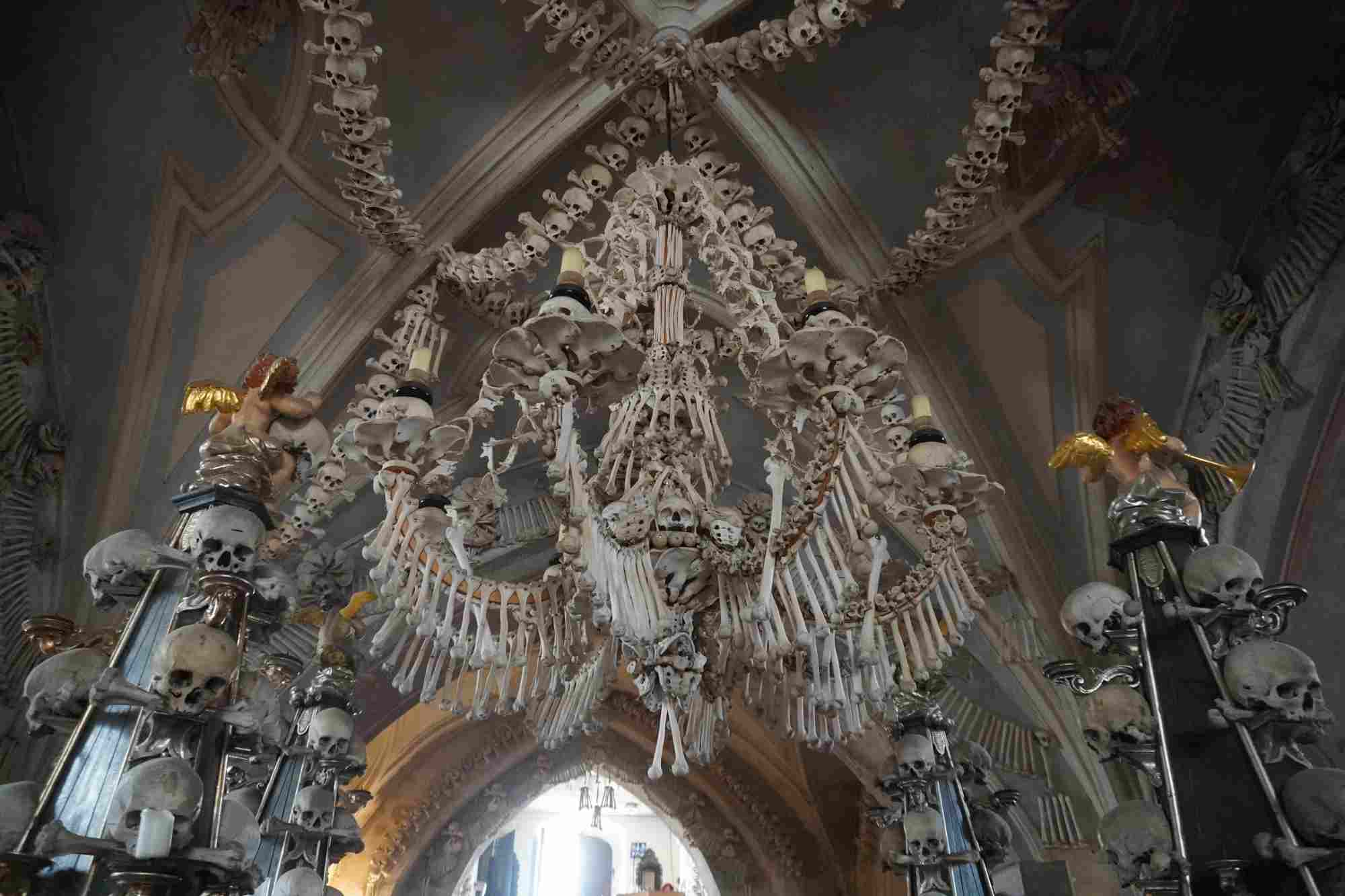
Part of her thesis is a case study of the ossuary in Kutná Hora, a UNESCO world-heritage site in the Czech Republic, which at Kostnice Sedlec—or Ossuary Sedlec —holds one of the most famous human bone displays in the world.
What makes this experience so visceral? Maybe it’s “that wrongness, the uncanny,” the Rochester undergraduate thought as she toured the site. She met Australian tourists there who told her they liked horror movies and admitted to having come for the thrill. Others were trying surreptitiously to snap pictures, which the ossuary had begun prohibiting two years earlier. What surprised Granato was that for all the clear trappings of a successful tourist site, replete with gift shops hawking skull souvenir mugs, candles were still burning inside the ossuary, lit by visitors as a sign of remembrance.
“To me that was really profound, because going into this I didn’t really expect any sort of real spiritual experience from any visitors,” she says. “But to me, it was very important that it does still happen.”
There’s a theological argument in Medieval Christian religion, Granato points out, that bodies ought to be buried intact so that the dead could be resurrected on the Day of Judgment. That’s why, even with the scarcity of space, bodies were usually first buried in graves. But the very notion of an ossuary seems to run counter to that Christian dictum. Indeed, Granato found that some medieval Christians paid to keep their relatives in their original spots in the cemetery, rather than have their bones transferred (and mixed up with others) in ossuaries.
“This fact creates socio-economic distance between who is displayed and who isn’t, which becomes conflicting evidence,” Granato says. In the ossuary of Kutná Hora, she found that an artist, working on behalf of a wealthy family, turned the bone collection in 1870 into the decorative display that still greets visitors today. Yet, the Ossuary Sedlec is located in a cemetery church on what is considered by many holy ground, and certainly sanctioned by the Christian Church.
She wondered—would the people, whose remains are displayed there, have given their consent?
“We can’t really know,” Granato says. “We can speculate, based on our study and research as historians and archaeologists. But that’s all.”
She allows, however, that there are indeed instances where the study and display of human remains is important. For example, Granato says, early Christians in Rome may have wanted their remains kept in crypts (that they considered holy) and saw visits by other Christians to these sites as a necessary and important part of their religious identity. “By continuing to visit and learn from these remains, tourists and scholars might be participating in this valued religious and cultural tradition,” she adds.
Granato explores in her thesis a second example, the Hyrtl Skull Collection at the Mütter Museum in Philadelphia, Pennsylvania, one that seems diametrically opposed to the Sedlec Ossuary, with its religious, spiritual, and even artistic display of human remains.
In 1874, the Mütter Museum acquired the collection of 139 human skulls from Viennese anatomist Josef Hyrtl, who had assembled them for a scientific study. Many of the skulls had come from people who had been hanged as criminals, or lived in poor houses, or other marginalized communities—places where it’s doubtful anyone would have sought their consent, says Granato.
“You do learn a lot about medicine in the 19th century,” she says. “The museum is very educational, if you engage with it in the right way.” However, it also offers the venue to parties and weddings with human skulls and skeletons as backdrop, which Granato finds “unsettling.”
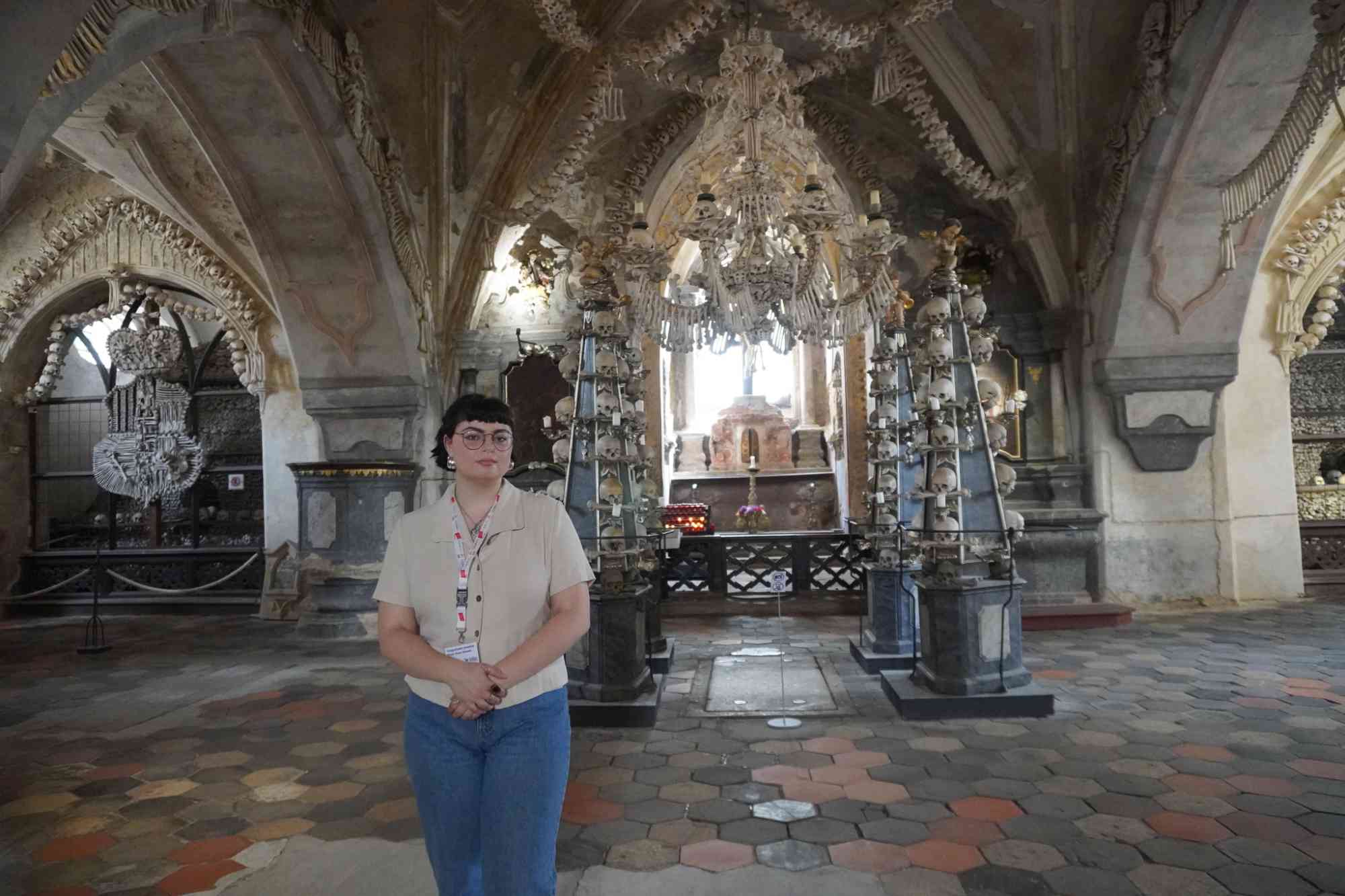
Granato argues that, whether intentionally or not, both sites—the ossuary and the museum—represent “dark tourist experiences,” which she likens to “roller-coaster rides,” catering to those who seek thrills and “find enjoyment in confrontations with something frightening” and who may be proud of their ability to “experience something that others may be too scared to do.”
Granato argues that while tourists who visit these sites may recognize the significance of death and may feel “wrongness” or discomfort in the display of human bodies, “they often don’t attempt to engage with the site as intended.” Rather, she says, death and dying becomes a “commodity,” one that is “thrilling” and even “entertaining.”
Does that mean it’s unethical to display human remains?
“It depends,” says Granato. Generally, she finds that most archaeologists, academics, and museum curators think that the default answer is “yes, it is ethical” and may possibly question it later. “But I think the default answer should change to ‘no’—with the caveat that sometimes it is ethical.”
To Granato, it’s important that, “as archaeologists, excavating and interacting with human remains, we say by default, ‘This is a person with inherent rights, and we need to be respectful of their wishes.’”
Says Colantoni, “It’s exciting and fulfilling for me as her mentor to see how Julia is using her research to make museums and the field of archaeology into more humane and respectful spaces.”
Right now, Granato is in the thick of applying to graduate programs, with the intention of becoming a professor of archaeology.
“My work has really only just begun,” she says.
Read more about undergraduate research at Rochester
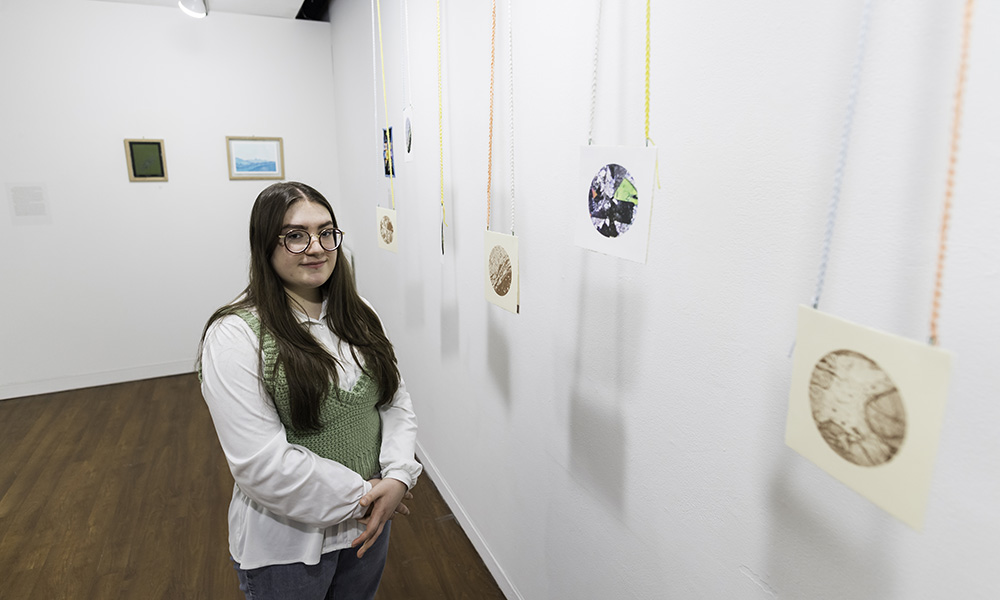
An art and geology double major, University of Rochester student Gabrielle Meli brings scientific processes to her art.
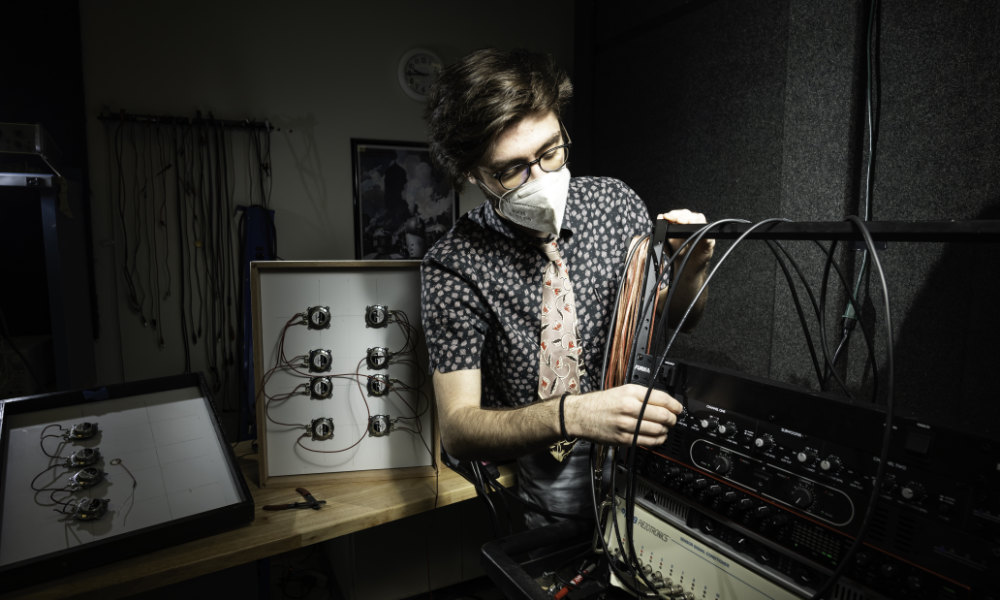
A Rochester team that includes Ben Kevelson ’22 is using flat panel technology to build a more cost-effective smart device that can also function as a touch interface.
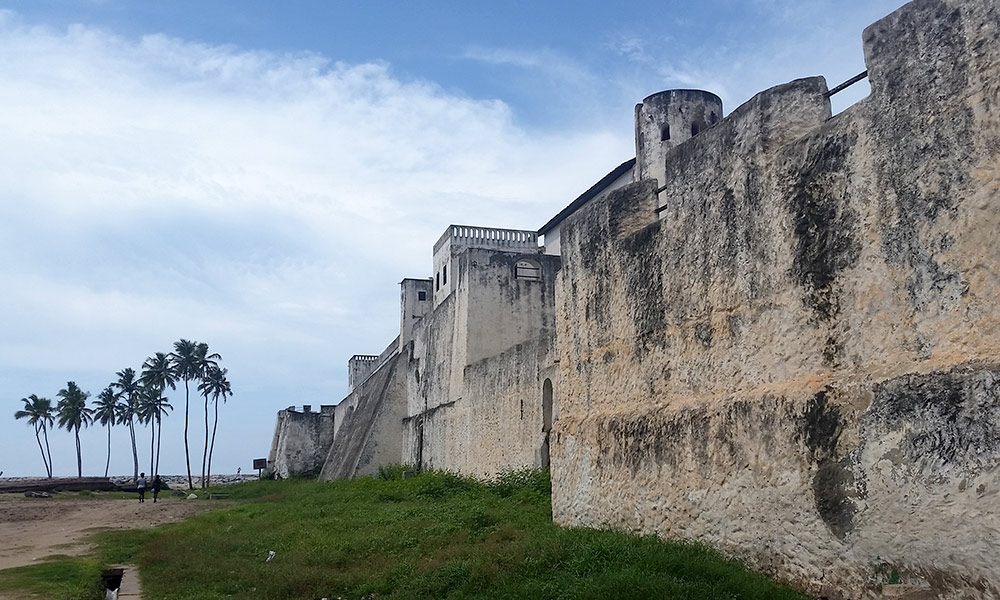
Rochester undergraduates worked to analyze and preserve the ancient forts along the coast of Ghana, while exploring the historical and cultural context of the structures.
More in Campus Life


There's a Reason It's Called Eternal
Experience every facet of the Eternal City, as well as surprising day trips you might have thought were impossible. Our prolific range of Rome tours has been created to deliver nothing less than Rome's best.
Our Top-rated Tours of Rome
Colosseum Tour with Roman Forum and Palatine Hill
Sistine Chapel, Vatican Museums, and St. Peter's Basilica Tour
All of our experiences.
VIP Amalfi Coast Tour with Pompeii & Positano from Rome
The marvels of the Amalfi Coast are not as far away you think on this carefully planned day tour from Rome riddled with the evocative landscapes and jewel-like towns you would expect of this UNESCO paradise. See Sorrento and the archeological site of Pompeii, all with an outstanding commentary from an expert local guide.
Guided Day Trip: Tuscany from Rome including Brunello Wine Tasting & Gourmet Lunch
Escape to the tranquility of Tuscany as you travel through breathtaking landscapes, visiting the rustic hill town of Montepulciano and a real Tuscan vineyard. Taste local pecorino cheese in Pienza. Enjoy an authentic gourmet Tuscan lunch with some great Brunello wine, and even visit the Church of St. Biagio.
The Original Crypts and Catacombs Tour
Delve beneath Rome's streets to discover its best-kept secrets. Explore the Capuchin Crypts and Roman Catacombs, concluding your tour with a visit to the medieval Basilica of San Nicola in Carcere. This immersive experience provides a unique perspective on Rome's rich and complex past, offering an unforgettable journey into the city's hidden treasures.
Exclusive Early Breakfast inside the Vatican Museums with Sistine Chapel and St. Peters Basilica
Enter the Vatican before it opens to the public for a rich breakfast in the beautiful Vatican's Courtyard. Afterwards you'll embark on a guided tour of the best of the museums with the Sistìne Chapel and more, without the crowds, topped by Skip the Line entry to St. Peter's Basilica and the Pietà.
Full Day Pompeii & Mt. Vesuvius Day Trip from Rome with Lunch
Skip the lines at the ancient city of Pompeii with our comfortable coach tour from Rome. Savor an all-inclusive Italian lunch with Bay of Naples views before choosing between climbing Mt. Vesuvius or a geologist-led exploration. From November to March, explore Positano, ensuring an unforgettable year-round trip.
Borghese Gallery & Gardens Tour
Visit one of Rome's finest art collections on this Borghese Gallery tour with an expert guide to see masterpieces by Bernini, Canova and Caravaggio. Second only to the Vatican in importance, this smaller museum housed in a fabulous Renaissance with gardens will leave you speechless and we make sure you get tickets.
Colosseum Guided Tour with Gladiator's Entrance, Arena Floor Access, Roman Forum & Palatine Hill
See the Colosseum from the best vantage point. Not from above, but from where the action happened on the Arena Floor. This unique tour grants you entry through the same arches the gladiators used to access the stage through its coveted back door.
Amalfi Coast & Positano Tour from Rome with Boat Cruise & Limoncello Tasting
Discover the stunning Amalfi Coast and experience a fantastic boat ride from Salerno to Positano and Amalfi: explore these stunning towns and enjoy a Limoncello tasting experience.
Semi-Private Sistine Chapel, Vatican Museums & St. Peter's Basilica Tour
With a small group of 10 people, this semi-private tour is a relaxing way to explore the miles of museums in the Vatican. Bypass the lines to the Sistine Chapel and St Peter's Basilica with our Reserved Access to the Vatican Museums
Day Trip from Rome: Tuscany Exploration with Brunello Wine Tasting and Visits to 3 Regions
Embark on an unforgettable day trip from Rome with our local experts, exploring three distinctive regions that promise a blend of unique cultural and culinary experiences. Wander through the enchanting streets of Civita di Bagnoregio, indulge in the culinary delights of Tuscany, experience the richness of Brunello wine tasting, and discover the charming town of Orvieto with exceptional flair.
Skip-the-Line Entry: Borghese Gallery with Optional Audio Guide
Access the Borghese Gallery directly, bypassing queues to maximize your time with exquisite artworks. Enhance your exploration with our optional audio guide, delivering insightful commentary and additional information on the museum's masterpieces.
Jewish Ghetto and Trastevere Food Tour with Dinner
Indulge in the authentic flavors of Rome during our intimate small-group culinary adventure. Stroll through the picturesque streets of the Jewish Ghetto and discover the hidden gems of Trastevere, guided by a passionate local expert. This tour is a delightful array of local flavors, from traditional bites to the trendy Aperol Spritz, and culminates the day with a scenic meal in Trastevere.
Pasta Making and Wine Tasting Experience in Trastevere
Enjoy an authentic Pasta Making Class in Rome's historic Trastevere district, renowned among locals for its exceptional food. Under the guidance of an English-speaking chef, savor the flavors of your culinary creations, expertly paired with local wines for a truly satisfying epicurean adventure.
Best of Rome Walking Tour
See Rome's most important monuments, piazzas and fountains on this in-depth walking tour of the Eternal City's top attractions. Visit the Spanish Steps, Trevi Fountain, Pantheon, Piazza Navona and more with an expert guide leading the way. It's a perfect compliment to our Vatican or Colosseum tour for an in-depth look at Rome's best.
Half Day Semi-Private Ancient Ostia Ruins Tour from Rome
Experience an unparalleled journey into the Ancient Roman world on this tour of the Empire's port, Ostia Antica. Just a 30 minute train ride from Italy's capital, you will be transported back to 4 BC at ruins that are so well-preserved they are known as the 'Better Pompeii'.
E-Bike Tour: Appian Way & Hidden Gems of Rome
Discover the allure of Rome by biking through its historic streets, revealing hidden gems and retracing the footsteps of the Romans. Journey from the resonant echoes of Circus Maximus to the captivating 'Quo Vadis' church and the majestic Mausoleum of Cecilia Metella. This immersive expedition promises stunning views at every turn.
Day Trip from Rome: Pompei, Sorrento, and the Amalfi Coast
Experience a captivating adventure with our Rome to Pompei, Sorrento, and Amalfi Coast Tour. See the mysteries of Pompeii, experience the enchanting charm of Sorrento, and marvel at the breathtaking landscapes of the Amalfi Coast – a full day's immersion into the sweet life of La Dolce Vita.
Ghosts, Mysteries and Legends of Rome Night Walking Tour
Another side of Rome comes out as the sun goes down, and the mysteries and hidden secrets of the city begin to speak. Join us on this unique tour of the Eternal City as few tourists have seen it, a place where facts and legends intertwine, and the passing of centuries can't mute the voices of its uncanny tales.
Colosseum Evening Tour with Arena Floor and Roman Forum
Get inside the Colosseum at evening when the daytime crowds are gone and the summer heat is at bay. See areas that are off-limits to standard ticket holders like the Arena Floor. Includes highlights of the Roman Forum from Via dei Fori Imperiali.
Day Trip to Pompeii & Positano from Rome with Limoncello Tasting Experience
Discover the very best of Pompeii, and pop to Positano for a spot of Limoncello on this day trip from Rome!
Escorted Entry to the Colosseum with Skip-the-Line Tickets
Don’t want to wait in line for hours outside the Colosseum? Use our Skip-the-Line Access and then wander where you choose and at your own pace.
Private Colosseum Tour with Roman Forum and Palatine Hill
This is the private version of our most-popular tour of the Colosseum, Roman Forum and Palatine Hill. See the three stars of Ancient Rome's archaeological area like a VIP with your own private guide and benefit from the convenience, flexibility and intimacy that make private tours so different.
Private Sistine Chapel, Vatican Museums and St. Peters Basilica Tour
This is the most intimate and unique way to visit the Vatican - just you and your private guide. You will have one-on-one interaction as you experience the Sistine Chapel, Vatican Museums and St. Peter's Basilica, where you can spend extra time on your own after the tour.
Inspirational Thoughts for Your Tour in Rome

5 offbeat attractions in Rome
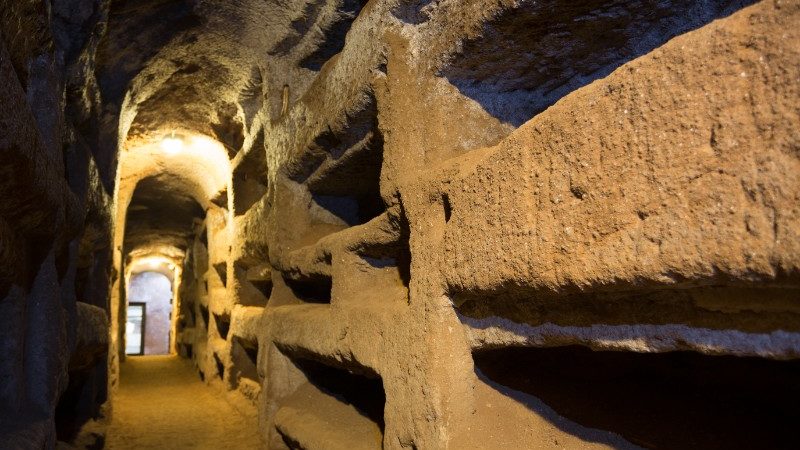
Rome may be one of the most conventional tourist destinations on the planet, with iconic attractions that have been world-famous for thousands of years.
But buried under all of those well-worn cobbled paths lies a Rome rarely explored. From a crypt exhibiting 4,000 decaying Franciscan monks to an archaeological site spanning several subterranean levels, this is the version of Rome without millions of other tourists.
1. Santa Maria della Concezione of the Capuchins: The Capuchin Crypt
The first thing you notice as you descend into the Capuchin Crypt is the damp, musty smell. Comprised of six rooms dotted along a dark hallway under the Church of the Capuchins, the crypt is decorated with the skeletons and decaying remains of around 4,000 Capuchin monks. Here you’ll find chandeliers made entirely of vertebrae hanging from low ceilings, decaying corpses baring their remaining teeth at you through the iconic hoods of their Capuchin robes, all while a child’s skeleton fashioned as Death itself stares at you through the candlelight.
Where the infamous Paris catacombs were all about simply storing human remains, the Capuchin Crypt is about displaying them in ornate, artistic and entirely horrifying ways.
RELATED: WHEN IN ROME – YOUR ULTIMATE GUIDE
2. The Basilica of St Clement: The Archaeological Excavations
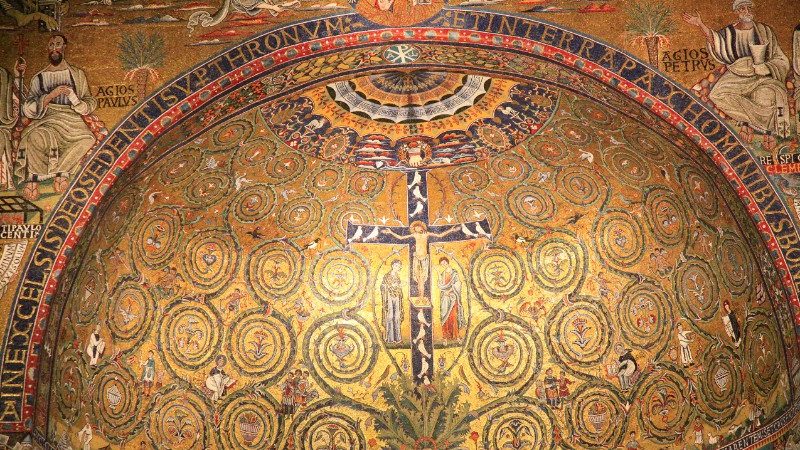
Photo by Vlad G, Shutterstock
By descending through the Basilica of St Clement, you will pass through over 1,000 years of Roman history and track the fall of the Roman Empire. At ground level is the titular basilica, built around 1100 AD and known for its lavish gold decor and the enormous mosaic above the altar. Head down a nearby stone staircase and you’ll enter the dim and gloomy 4th-century basilica, discovered when Father Joseph Mullooly opened the archaeological excavations in 1857. Scattered throughout this floor are decaying frescoes dedicated to the deeds of St Clement.
Take a narrow, winding staircase down one more level and you will be immediately greeted by a waft of damp air, courtesy of the damaged water pipes buried in the floor’s rear. Welcome to the first century. Here you’ll find altars, schools and prayer rooms built by the secretive cult of Mithras and, through a narrow alley, a series of rooms thought to be home to the mint of ancient Rome.
3. Parco Savello: The Garden of Oranges
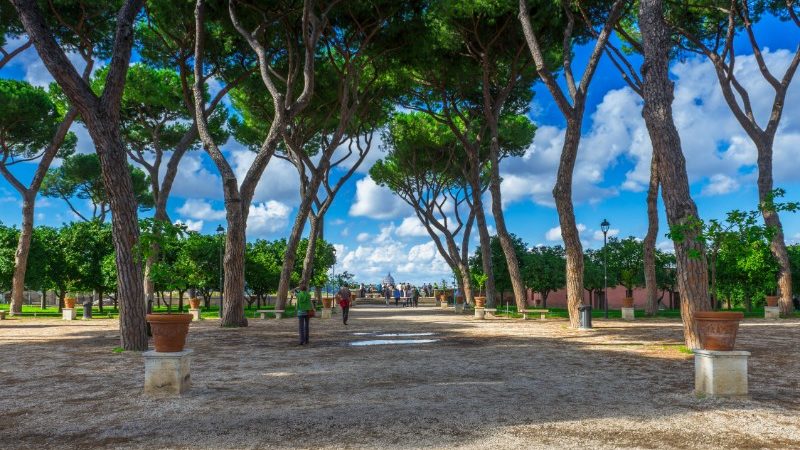
Photo by Catarina Belova, Shutterstock
Ironically, the Garden of Oranges might be best known for its panoramic view of Rome. From the lookout point, you can see both the national monument in Piazza Venezia and the iconic dome of St Paul’s in Vatican City. That said, the garden itself is the perfect spot to escape the heat on a summer’s afternoon. Its lush green grass and the generous shade provided by its picturesque orange trees are a hidden oasis away from the noise of the city.
And when you’re ready to hit the cobbled streets again, you’ll find both the Mouth of Truth and the Circo Massimo within a 10 minute walk.
RELATED: THE BEST FOOD IN ITALY – YOUR CITY-BY-CITY GUIDE
4. Centrale Montemartini Museum: The Machines and the Gods
Abandoned since the 1960s, the Giovanni Montemartini thermoelectric power plant is now home to a stunning array of sculptures and antiquities from the Capitoline Museum collection. A unique combination of industrial-age machinery and ancient artefacts, the museum’s creation was actually completely unplanned — several wings of the Capitoline Museum were closed down for renovation and their pieces simply had no better place to go. First opened to the public as the temporary exhibition, “the Machines and the Gods,” in 1997, it became so popular the city made it a permanent museum in 2005.
5. Piazza Vittorio: The Porta Alchemica
Hidden in the north-western corner of the Piazza Vittorio Emanuele II is the Porta Alchemica, or the Alchemy Gate. Inscribed with strange symbols, the gate’s history and purpose is shrouded in mystery and has stoked conspiratorial debates amongst Romans for centuries. One legend holds that an alchemist visited the villa in the early 17th century, convinced it was home to a herb that could turn objects to gold. He disappeared that night through the wall where the Porta Alchemica now stands, leaving behind a few flakes of gold and a manuscript covered in the bizarre symbols inscribed on the gate. Another legend involves the exiled queen Christina of Sweden, a secret alchemical laboratory and the murder of several prominent alchemists.
See the many sights of Rome on an Intrepid small group adventure in Italy now.
Feature image by David Soanes, Shutterstock
Feeling inspired?
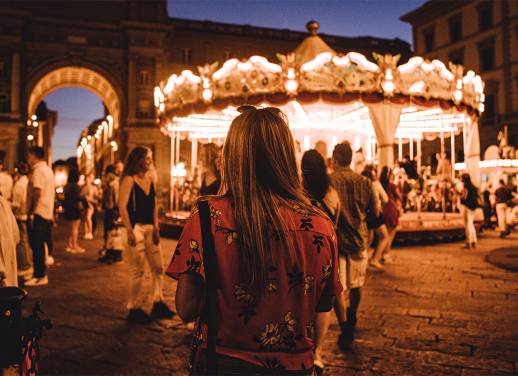
Sean Sebastian
Sean is a freelance writer born in Melbourne and based in London. The only thing he has consistently loved in his life is travel (sorry, family and friends) and looks forward to crossing off the enormous list of cities on his bucket list. He tweets from @seanjseabass
You might also like
The 7 best places to go on a..., 5 reasons to visit sri lanka in the..., why 2024 is the best year to see..., yellowstone vs yosemite: which national park to visit, 6 unique experiences you can have in el..., from delhi to udaipur, here are the five..., cinque terre vs amalfi coast: which destination to..., love at first bite: 10 famous sandwiches from..., galapagos or madagascar which unique destination should be..., central vs south america: how to plan your..., 4 reasons you should take a road trip....
- The Magazine
- Stay Curious
- The Sciences
- Environment
- Planet Earth
Dark Tourism: Why People Travel to Sites of Death and Tragedy
Droves of tourists frequent concentration camps, sites of famous battles or even places where mass atrocities occurred. what draws us to this dark tourism.
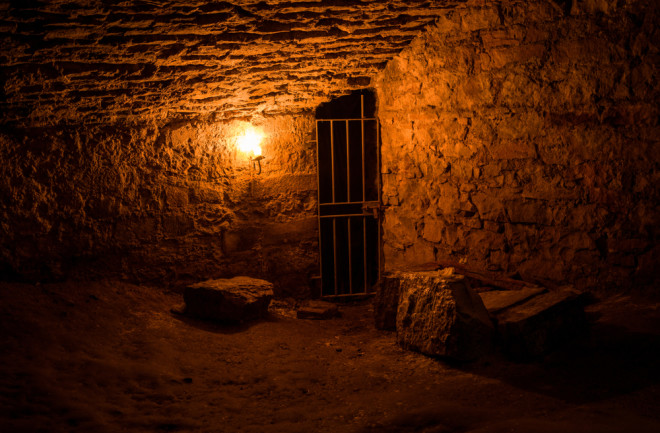
If you've ever traveled somewhere new, there's a good chance you've planned your itinerary around popular destinations to make the most of your trip. That’s why famous museums, parks, restaurants and beaches are commonly filled with people trying to experience what makes a particular location so great. But some of us have a penchant for places that are historically associated with death and tragedy. All around the world, these tourists visit concentration camps, historical grounds of famous battles or even places related to mass atrocities.
Today, this practice — fittingly called "dark tourism" — is a multi-billion dollar industry. But it's also far from a new phenomenon. Some people have always been drawn to death, and two of the earliest examples are the displays of public executions and the Roman gladiatorial games. The Colosseum in Rome may very well be one of the first dark tourism attractions. But what is it about these locations that make them so engaging? According to experts, there are plenty of factors that help draw us to these lurid locales.
The Appeal of Death and Tragedy
The motivations of tourists in visiting dark tourist locations often come down to four common themes, according to a 2021 study published in International Hospitality Review . Curiosity appears to be the biggest factor, but personal connection also matters. Many tourists take part because they feel connected — or want to feel a connection — to the events that transpired at a particular location, says Heather Lewis, assistant professor at Troy University who was involved in the 2021 study.
Others visit for educational purposes, while some just happen to be in the same place and decide to participate after seeing something that might be of interest, she adds. For some people, visiting the graves of celebrities they like is a way to celebrate their lives, and it’s not about focusing on the difficulty of their life, or the tragic circumstances behind their death.
“Dark tourism does not need 'dark' tourists — only people who are socially engaged in the cultural and political fabric of their own life world,” says Philip Stone, executive director of the Institute for Dark Tourism Research. “[It] is the commodification of places of pain and shame and, consequently, shines a mirror on contemporary society of how we memorialize, and who we remember.”
The concept of dark tourism is culturally nuanced and means different things to different people. It can mediate our sense of mortality through the fatality of others where the dead act as warnings from the history of our own fights, follies, and misfortunes, says Stone. In short, a fascination with death in itself might not be the primary motive for visiting dark tourism sites; it likely has more to do with an individual's interest in cultural heritage and education.
A Complex Legacy
Still, despite that nuance, dark tourism is often frowned upon. For tourists and travelers, it can seem like a minefield mired in “ moral ambiguities and managerial dilemmas,” says Stone. In many ways, the industry is all about managing our collective memory and providing a memorialized afterlife to those who died tragically or untimely. At the same time, it allows contemporary visitors to consume narratives of death that have been streamlined for their consumption. In other words, the practice can be considered a "touristification" of the places and people steeped in death and tragedy.
“Remembrance is a political process that is selective of what, who, and where is memorialized — and, perhaps more importantly, forgotten,” he adds. “As such, dark tourism showcases our significant dead as spectacular in a society of spectacle where commercialism ensures everything is 'packaged up' and sold, even tragic or calamitous death.” At its core, there is an element of dark tourism that knowingly exploits our fascination with the macabre, stirring up complicated ethical and moral issues about our own behavior.
For Lewis, dark tourism isn’t necessarily a bad thing as long as it’s properly managed. The increase in tourism can be used to restore or maintain facilities in dark tourism locations, but it should not destroy or diminish the integrity of the location over time. For instance, there are Hurricane Katrina tours that will not visit certain parts of the city out of respect for the individuals living there, she adds.
People must always be respectful of those who have experienced loss and hardship at dark tourism locations. Traveling responsibly and minimizing its impact on residents remain highly important because old suffering may be reopened, intensified, and prolonged by tourists.
“The overall concern that we should have with dark tourism is making sure that we are being ethically and morally upright in the marketing and use of these locations as a dark tourism destinations,” says Lewis. “We should never seek economic gain by exploiting others’ suffering and loss.”
- behavior & society
Already a subscriber?
Register or Log In

Keep reading for as low as $1.99!
Sign up for our weekly science updates.
Save up to 40% off the cover price when you subscribe to Discover magazine.

IMAGES
VIDEO
COMMENTS
Rome 37 - cats on plinths at Torre Argentina. Rome 38 - cobbled little street in the Centro Storico. Rome 39 - Monti. Rome 40 - quiet cobbled side street in Trastevere. Rome 41 - Provolone cheeses. Dark Tourism - the online travel guide to dark, unusual & weird places around the world.
The Macabre, Strange & Interesting Dark Tourism Destinations of Rome! 1. The Colosseum. Centuries ago, the Romans sat at the head of the metaphorical global table, with an unfathomable infrastructure and society that in some instances outdoes modern times. But unlike modern society, the world of technology was somewhat premature.
At Dark Rome, we create unique experiences in Italy's most famous cities. Vatican. Rome. Florence. Naples. Venice. Milan. Pompeii & Amalfi. Why choose a Dark Rome tour. Here's Why. Thousands of 5-Star Reviews. Previous. The tour day was broken up very well. 04 Apr 2023. Laura.
The Original Crypts and Catacombs Tour, Dark Rome. Take this tour of Rome's underground crypts and catacombs to see a different side of Roman culture stretching back to the 1st century. Mysterious ...
Hear the legends and ghost stories that keep Roman kids up at night as your guide brings the Eternal City's most enthralling historical and supernatural mysteries to life in a highly entertaining and informative night walking tour that is unlike any other. Cancelation Policy. This tour is subject to a 24-hour cancelation policy.
The Colosseum in Rome is an attraction today, despite being the scene of countless violent deaths. Sam valadi, CC BY. Today, in parallel with the growth in popularity of dark tourism is the ...
The catacombs in Rome, carved out of the soft volcanic rock found in Rome's stone foundations, served as both a place of worship and a resting place for believers who had died. Over time, as Christianity became a powerful and accepted force, Christian worship moved above ground. But the catacombs continued to play an important role in Roman ...
When you think of Italy, more than likely thoughts and images of the rolling hills of Tuscany; the stunning beaches of the Italian Riviera and Amalfi Coast; the magical islands of Ischia and Capri with their quaint trattorias along narrow, cobblestoned streets; and the gondola-laden canals of Venice come to mind. Vibrant and bustling tourist destinations like Florence, Rome, and Milan are ...
Beneath the surface lie ancient tombs, hidden temples, and buried works of art. Go beyond the superficial sites of Rome with a peek underground in one of the Rome day tour of the catacombs. The Crypts and Catacombs Tour of Rome was one of the original tours offered by Dark Rome. The tour of the catacombs begins at Piazza Barberini where you ...
Join Rome's best storytellers for an after-dark stroll through Rome to explore the tales of ghosts, gruesome executions, and infamous murders. Become a supplier; Wishlist; ... A wonderfully unique way to get to know the city in a different light - away from the normal tourist routes. Our guide skilfully combined Rome's legendary stories with ...
The entrance and guided tours meeting points are on the western side of the Colosseum. Most of the time the queues outside are just as impossible to miss as the building as a whole. Opening times: daily from 8:30 a.m. to between 4:30 p.m. in winter to 7:15 p.m. in summer. Last admission an hour before closing.
Dark tourism refers to visiting places where some of the darkest events of human history have unfolded. ... a backpacker who treks to the Colosseum in Rome, or a tourist who seeks out the near ...
Dark Rome Tours is a tour company which offers guided tours in Rome, the Vatican, [1] [2] Florence, Venice, Milan and Paris. They specialize in small group tours which access to major historical and cultural sites without waiting in line. [3] As well as walking and bus tours, Dark Rome offers thematic day tours from Rome (visiting Pompeii ...
It all started with an idea: taking a small group of visitors around the historic center of Rome and telling them the little-known stories, mysteries, and legends that would bring the ancient streets to life. It was so much fun that one tour led to another, and another, and another. Eventually, Dark Rome was operating beyond Rome: in the ...
Tour Highlights. Step into the shadows of ancient Rome and uncover the eerie secrets and ghostly tales on the Dark Side Walking Tour. This family-friendly tour offers a unique experience where visitors can explore haunted stories while exploring the historical streets of Rome.. From the site of Julius Caesar's assassination to the mysterious Castel Sant'Angelo, you will be immersed in ...
15. The Colosseum, Rome. Built in Ancient Rome between 72-80 AD, the Colosseum is one of the oldest and most recognizable dark tourism sites. At the time, it was the largest amphitheater ever built with a capacity of 50,000-80,000 spectators.
The Colosseum in Rome is another iconic spot. Imagine the roar of the crowd as gladiators fought to the death. It's a place steeped in blood and drama, a perfect example of how dark and mainstream tourism often overlap . ... Can you list some popular dark tourism destinations in Italy? Popular destinations include Pompeii, the Capuchin Crypt ...
17 Polignano a Mare. 18 La Spezia. 19 Palau. 20 Cala Gonone. Discover a different side to Rome on the city's only night-time walking tour in English. Explore the hidden side of the Eternal City on a mysterious 1.5-hour night tour, and learn about Rome's supernatural side as you check out Campo de Fiori and more.
The ethics of dark tourism. Rochester undergraduate Julia Granato crisscrossed Europe this past summer to study human bone collection and display sites in Prague, Vienna (pictured here at the pathological-anatomical collection at the Narrenturm, part of the Naturhistorisches Museum Wien), Florence, Rome, in addition to the US-based Mütter ...
Rome at night is a magical experience that you won't want to miss. The city's ancient ruins and historical landmarks are illuminated by soft lighting, creating a charming and romantic atmosphere. Some of our best memories at Rome are exploring this gem after dark when most tourists have returned to their hotels.
Experience a captivating adventure with our Rome to Pompei, Sorrento, and Amalfi Coast Tour. See the mysteries of Pompeii, experience the enchanting charm of Sorrento, and marvel at the breathtaking landscapes of the Amalfi Coast - a full day's immersion into the sweet life of La Dolce Vita. 5.00. (4 Reviews)
Rome may be one of the most conventional tourist destinations on the planet. But buried under those well-worn paths lies a Rome rarely explored. From a crypt exhibiting 4,000 decaying Franciscan monks to an archaeological site spanning several subterranean levels, this is the Rome without the millions of tourists.
The Appeal of Death and Tragedy. The motivations of tourists in visiting dark tourist locations often come down to four common themes, according to a 2021 study published in International Hospitality Review. Curiosity appears to be the biggest factor, but personal connection also matters. Many tourists take part because they feel connected ...